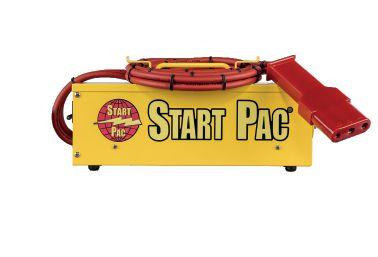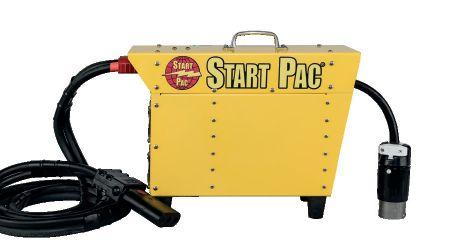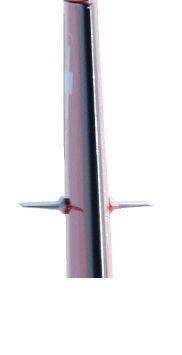

SkyAlyne begins FAcT build
Flight Training Unit shifts
Losing
The challenges facing MROs



SkyAlyne begins FAcT build
Flight Training Unit shifts
Losing
The challenges facing MROs

At Perimeter Aviation, we connect cultures, communities, and careers. careers.perimeter.ca
Build a rewarding career in an environment committed to safety and supported by a leadership team of seasoned pilots. With advanced training programs, a variety of route options, and �exible single-day pairings, you'll have the freedom to progress at your own pace.
Whether transporting essential food and cargo, delivering critical medical supplies, or ensuring passengers reach their destination, you are connecting critical horizons across northern communities in Manitoba and Ontario. From training to take-o�, your work makes a di�erence.

Direct Entry Dash 8 and Metro Captains
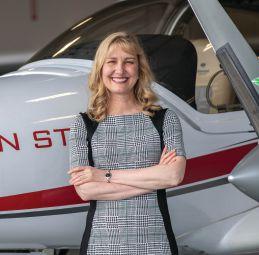

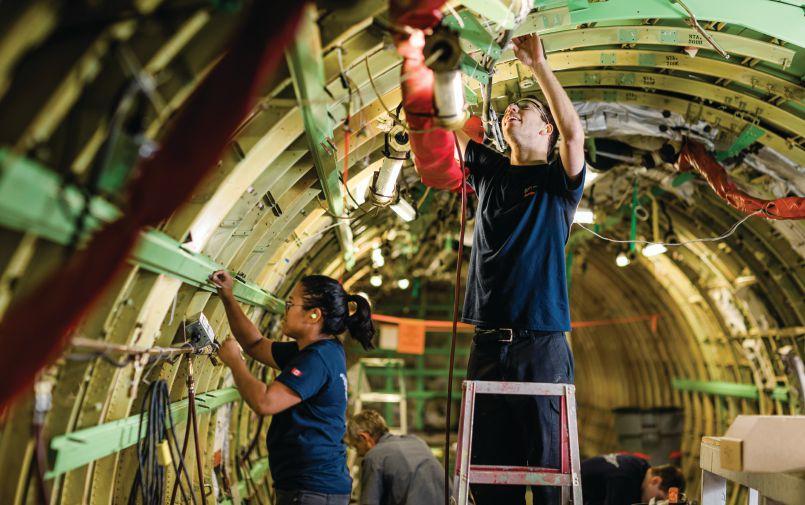




READER SERVICE
Print and digital subscription inquires or changes, please contact Angelita Potal, Customer Service apotal@annexbusinessmedia.com 416-510-5113
Mail: 111 Gordon Baker Rd., Suite 400, Toronto, ON M2H 3R1
EDITOR Jon Robinson jrobinson@annexbusinessmedia.com 647-448-6188
FLIGHT DECK
David Carr, John Gradek, Eric Kennedy, Kendra Kincade, Phil Lightstone, Steven Sitcoff, Edward Smith
NATIONAL ACCOUNT MANAGER Mena Miu mmiu@annexbusinessmedia.com 416-510-6749
ACCOUNT CO-ORDINATOR Barb Vowles bvowles@annexbusinessmedia.com 416-510-5103
MEDIA DESIGNER Curtis Martin
GROUP PUBLISHER AND VICE PRESIDENT OF SALES Martin McAnulty mmcanulty@annexbusinessmedia.com
CEO Scott Jamieson sjamieson@annexbusinessmedia.com
WINGS MAGAZINE
P.O. Box 530, 105 Donly Dr. S., Simcoe, ON N3Y 4N5 Tel: 519-428-3471 Fax: 519-429-3094 Toll Free: 1-888-599-2228
Printed in Canada ISSN 0701-1369
PUBLICATION MAIL AGREEMENT #40065710
Published six times per year (Jan/Feb, Mar/Ap, May/Jun, Jul/Aug, Sep/Oct, Nov/Dec) by Annex Business Media
SUBSCRIPTION RATES
Canada – 1 Year $35.19 CDN; 2 Years $61.71 CDN (plus GST - #867172652RT0001)
USA – 1 Year $80.07 CDN
International – 1 Year $92.31 CDN
Occasionally, Wings magazine will mail information on behalf of industry-related groups whose products and services we believe may be of interest to you. If you prefer not to receive this information, please contact our circulation department in any of the four ways listed above.
Annex Privacy Office privacy@annexbusinessmedia.com • Tel: 800.668.2374
No part of the editorial content of this publication may be reprinted without the publisher’s written permission.
©2024 Annex Business Media All rights reserved. Opinions expressed in this magazine are not necessarily those of the editor or the publisher. No liability is assumed for errors or omissions.
All advertising is subject to the publisher’s approval. Such approval does not imply any endorsement of the products or services advertised. Publisher reserves the right to refuse advertising that does not meet the standards of the publication.

Annex Business Media brands focused on Canadian aviation and aerospace include Wings, Helicopters and UAV Canada, as well as the Careers in Aviation Expo and Directory, Aerial Firefighting Guide and the MRO Directory. Annex is the publishing partner of Canadian Owners and Pilots Association, providing essential news and market content through COPA Flight, COPAnational.org and Canadianplanetrade.ca.


By Jon Robinson
Dubai International Airport, DXB, welcomed a record 44.9 million guests during the first six months of 2024, marking what its operator, Dubai Airports, describes as an eight per cent increase from the same period last year. DXB is described as the world’s busiest airport for international travel and often looked at as a barometer by major airlines and airports.
Canada’s airport barometer, Toronto Pearson, operated by the Greater Toronto Airports Authority (GTAA), on August 7 released a report of its half year (second quarter) financial results with a 7.2 per cent increase in revenues, at $953.8 million, relative to the first six months of 2023, at $889.4 million. During the six months ended June 30, 2024, Toronto Pearson processed 22.6 million passengers, an increase of 6.2 per cent relative to the same period in 2023. Passenger activity continued to recover to 92.7 per cent in the first half of 2024, when compared to the same period of 2019.
GTAA notes its financial results are attributed primarily to an increase in passenger and flight activity, and higher aeronautical rates, while a decrease in cash flows was driven by an increase in capital expenditures. The GTAA in 2023 launched a 10-year Strategic Plan and will make major capital expenditures under a series of flexible, prioritized projects. The operator sums up its vision as “putting the joy back into travel by making Toronto Pearson the chosen place to fly and work”. The GTAA explains its mission is to make YYZ a global leader in airport performance, customer care and sustainability; and to create an airport of the future by innovating in all that it does.
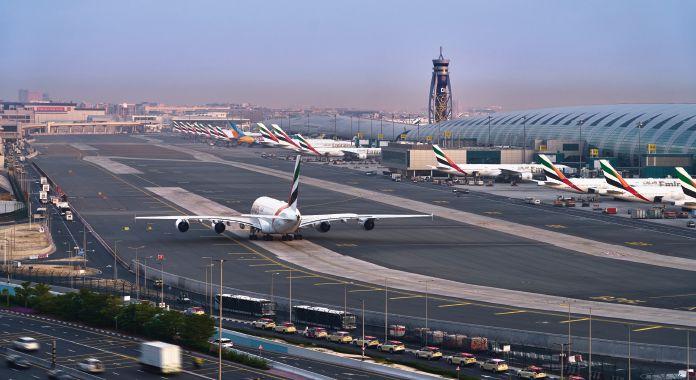
The average number of guests per aircraft movement at DBX in the first half of 2024 was 213, with a load factor of 77 per cent.
The importance of this mission to the Canadian economy can be drawn to the recent results released by DBX. Ideally, the high cost of living in Canada will soon be subdued by lower interest rates and return the country into its position as a preferred destination for tourism. Dubai attracted 9.31 million international visitors in the first half of 2024, according to Dubai’s Department of Economy and Tourism, which also noted a GDP increase of 3.2 per cent from the previous year. “Strong demand from key source markets such as India and the gradual but certain resurgence of markets such as China, have been instrumental in our success,” said Paul Griffiths, CEO of Dubai Airports.
TOP DATA BURSTS… in this issue
1. Canadian North is a 100 per cent Inuit-owned airline servicing 25 communities. P.7. 2. The new 777x wing reduces fuel burn by about 10 per cent. P. 10. 3. It is estimated Boeing has lost US$60 billion in sales because of fatal two 737 MAX crashes. P. 14. 4. Canada reduced the number of Student Permits by 35 per cent from 2023. P. 16. 5. Canada will need a minimum of 5,300 new aircraft mechanics by 2025. P. 22.
“We have a very optimistic outlook for the remainder of the year, and we are on track to break records with 91.8 million annual guests forecasted for 2024.”
In the first half of 2024, India remained DXB’s top destination country with 6.1 million passengers, while traffic from China exceeded 1 million passengers, representing 80 per cent yearon-year growth and a 90 per cent recovery compared to 2019 levels. DXB’s top destination countries after India are Saudi Arabia with 3.7 million guests, the United Kingdom with 2.9 million guests and Pakistan with 2.3 million guests. Other significant markets include the United States (1.7 million guests), Russia (1.3 million), and Germany (1.3 million). The top three city destinations at DXB were London with 1.8 million guests, Riyadh (1.6 million), and Mumbai (1.2 million). DXB is connected to 269 destinations across 106 countries, served by 101 international airlines.
During YYZ’s first six months of 2024, the largest passenger growth was in the international sector with an increase of 1.4 million or 10.2 per cent, whereas the domestic sector decreased by 0.1 million passengers or 1.1 per cent, when compared to the same period in 2023. These positive international numbers speak to the potential of YYZ’s global vision as the domestic low-cost battle appears to be almost settled. | W

Take your career to new heights
Engineers are thinkers, makers and doers, finding solutions to the world’s biggest challenges. Your journey starts at the Schulich School of Engineering. LEARN MORE ABOUT OUR UNDERGRADUATE PROGRAMS
Airbus and the Government of Quebec are jointly investing US$1.2 billion in Airbus Canada Limited Partnership (Airbus Canada) in proportion to their respective share ownership. This represents an investment from Airbus of up to US$900 million and the Government of Quebec up to US$300 million, through Investissement Québec. Quebec holds 25 per cent of the Airbus Canada. A recent study produced by PwC estimates that the A220 program will have an economic impact in Canada of more than $40 billion over 20 years.
Airbus explains a five-year extension of the A220 Canadian partnership to 2035 will provide it with more time to create more value for the aircraft program, as it aims to deliver 14 aircraft per month in 2026. “We are consolidating the presence of Airbus, an aerospace giant, in a sector that creates enormous wealth for our
nation,” said François Legault, Premier of Quebec. “We are building a strong, prosperous and forward-looking economy in Quebec.” Airbus in 2018 took majority control of the A220 program, then called the C Series, through a partnership with the Government of Quebec.
“The A220 is the fruit of Quebec genius, and we can be proud of having developed one of the best aircraft in the world,” said Quebec Minister Pierre Fitzgibbon. “By extending our partnership with Airbus to accelerate activities around the development of the A220 aircraft, we are securing key jobs in the Mirabel region for years to come.” Airbus explains, that since taking over the program, the A220 order book has more than doubled to more than 900 aircraft to date and the number of employees has increased by 75 per cent, including 1,600 new hires in Quebec over the last two years, for a total of 3,500 people working on the A220.
Chorus Aviation in late July entered into an agreement to sell all assets in its Regional Aircraft Leasing segment, including Falko Regional Aircraft, to investment funds managed by HPS Investment Partners. Chorus purchased Falko in 2022. The transaction is valued at around $1.9

billion, of which $814 million is in the form of cash and $1.1 billion is in the form of aircraft debt to be assumed or prepaid by the buyers. Chorus notes the transaction will eliminate $1.7 billion in financings, including all Regional Aircraft Leasing (RAL) segment aircraft-related debt and substantially all Chorus corporate debt.
The two largest shareholders of Chorus, Brookfield Asset Management, holding approximately 13 per cent of Chorus’ outstanding common shares, and Air Canada, holding around eight per cent both supported the agreement. Chorus and Air Canada also agreed to amend and restate their investor rights agreement. Chorus provides regional service for Air Canada through Chorus subsidiary Jazz Aviation.
Canada Jetlines in early August grounded its planes, ceased operations and stated it would seek creditor protection, following the resignation of key executives, including CEO Brigitte Goersch. The company noted it faced a worsening financial situation and would need to raise additional capital to continue operations. Canada Jetlines described itself as a leisure airline, which also offered charter and ACMI service. The low-cost carrier focused on reaching sun destinations – primarily within the U.S., Caribbean and Mexico – utilizing Airbus A320 aircraft out of Toronto. The closure of Canada Jetlines follows the shuttering of Lynx Air in February, 2024, and Swoop in October 2023.
Southwest Airlines, in what it describes as a move to transform customer experience and improve financial performance, will assign seats and offer premium seating options on all flights. The airline has been well known for its open seating model for more than 50 years, but notes preferences have evolved with more customers taking longer flights where a seat assignment is preferred. Southwest also conducted operational testing that included live and more than 8 million simulation-based boarding trials. Its research indicated

that 80 per cent of Southwest Customers, and 86 per cent of potential customers, prefer an assigned seat.
In addition to assigning seats, Southwest will offer a premium, extended legroom portion of the cabin that research shows many customers strongly prefer. While specific cabin layout details are still in design, Southwest expects roughly one-third of seats across the fleet to offer extended legroom, noting the number is in line with what is offered by other airlines on narrowbody aircraft. Southwest also announced it is adding 24-hour operation capabilities with the introduction of overnight, redeye flights, beginning on Valentine's Day 2025 in five initial nonstop markets: Las Vegas to Baltimore and Orlando; Los Angeles to Baltimore and Nashville; and Phoenix to Baltimore. At the time, Southwest was facing a challenge from one of its Shareholders, Elliott Investment Management, which stated its intention to replace a majority of board directors by nominating 10 candidates.
Boeing at the end of July introduced Robert "Kelly" Ortberg as its next Chief Executive Officer. Succeeding Dave Calhoun, who was CEO since 2020 and a board member of Boeing since 2009, Ortberg is an industry veteran with more than 35 years of aerospace experience. Ortberg, 64, began his career in 1983 as an engineer at Texas Instruments, and then joined Rockwell Collins in 1987 as a program manager and held increasingly important leadership positions at the company prior to becoming its president
and CEO in 2013. After five years of leading Rockwell Collins, he steered the company's integration with United Technologies and RTX until his retirement from RTX in 2021. Ortberg holds a bachelor's degree in mechanical engineering from the University of Iowa. Boeing announced its new CEO as it reported a loss of more than US$1.4 billion in the second quarter.
Canadian North unveiled its state-of-theart CAE 7000XR Boeing 737NG FullFlight Simulator (FFS), located within its new 30,000-square-foot training facility at Edmonton International Airport. This new Canadian North facility with the latestgeneration CAE-built 737NG FFS will enable pilots to earn and maintain their proficiency in-country.
Canadian North is a 100 per cent Inuitowned airline that services 25 communities within the Northwest Territories, Nunavik
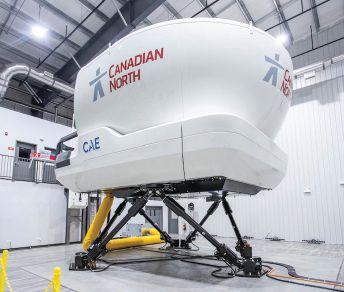
and Nunavut, along with Ottawa, Montreal and Edmonton. It operates a fleet of Boeing 737, ATR 42 and ATR 72 Freighter aircraft. Canadian North also regularly provides transportation for resource-sector clients, among other charter services. Canadian North states it has a vision to grow this facility, which holds ample space for additional training infrastructure.
Bombardier Inc. said it is opening a new European maintenance station located at the Farnborough, U.K. airport. The new location is meant to provide light scheduled and unscheduled maintenance and support for grounded aircraft. It brings Bombardier’s worldwide number of line maintenance stations to nine.
The Montreal-based business jet manufacturer also has service centres located in areas such as London, Berlin and Paris. It says its mobile response teams around the world are all equipped to quickly support Bombardier Learjet, Challenger and Global business jets.
Airbus’ Racer high-speed helicopter demonstrator, developed under the framework of the European Research Clean Sky 2 project, reached its fast cruise speed target of 407 km/h (220 kts). On June 21, less than two months after its first flight, the Racer demonstrator exceeded its level speed objective of 407 km/h (220 kts) by reaching 420 km/h (227 kts) in its initial configuration.
Airbus explains, that in just seven flights and about nine hours of flight testing, almost all of the flight envelope has been opened. The next phase of flight testing will focus on single-engine operations. The Racer also targets a fuel consumption reduction of 20 per cent, when compared to current helicopters in the same maximum take-off weight category, based on aerodynamic optimization and an eco-mode propulsion system.
Bell Textron delivered the 500th Bell 429 aircraft to Mendes Group for corporate transportation in Brazil. The aircraft acceptance took place at the Bell Textron Canada facility in Mirabel, Quebec, which oversees the production of Bell’s current commercial production line, including the Bell 505, Bell 407GXi, Bell 429 and SUBARU Bell 412EPX. To date, the company has built and delivered more than 5,800 commercial helicopters.
Bell Textron describes the 429 as one of the most advanced light twin helicopters in its class, providing exceptional speed, range and hover performance, as well as the capabilities as a single pilot IFR helicopter. It serves in a range of segments like air medical, public safety, oil and gas, utility, and corporate. The global Bell 429 recently surpassed 735,000 total fleet hours. The helicopter is powered by two Pratt & Whitney Canada PW207D1/

D2 engines. Bell explains it is the first helicopter certified through the MSG-3 process, resulting in reduced maintenance costs for operators.
Boeing outlined plans to invest $61 million to benefit two B.C. aerospace enterprises as part of its Industrial and Technological Benefits commitment to Canada for the selection of Boeing’s P-8A Poseidon long-range multi-mission aircraft. Boeing’s investment supports COTA Aviation, an Indigenous-owned aerospace and defence company based in Parksville, B.C. This investment will equip COTA with manufacturing equipment and allow it to establish a hands-on aerospace manufacturing training facility. Boeing is also investing in data analytics at its Vancouver location.
The Government of Canada announced its decision to acquire the P-8A Poseidon aircraft in November 2023, building on more than$2 billion in P-8 contracts with Canadian companies to date. According
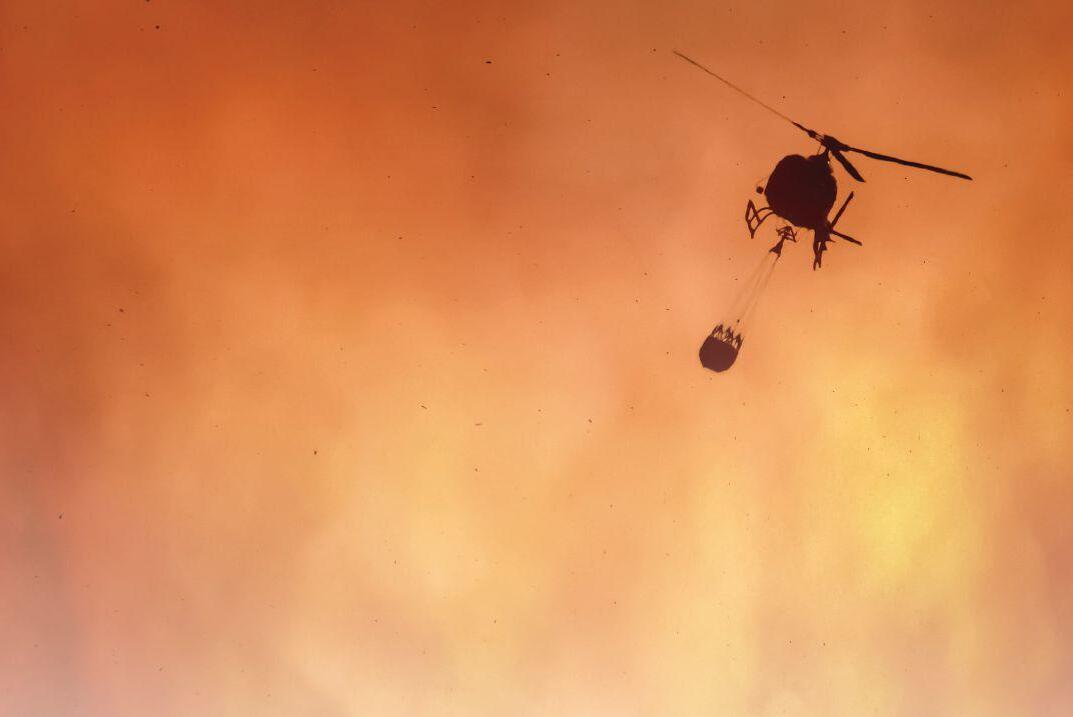

to a study by Ottawa-based Doyletech Corp., the purchase will generate benefits of nearly 3,000 jobs and $358 million annually in economic output to Canada.
Coulson Aviation was awarded a new 10-year, AUD$400 million contract ($369 million in Canadian funds) with Australia’s New South Wales Rural Fire Service. Coulson will manage, operate and maintain the entire fleet for New South Wales (NSW) Rural Fire Service (RFS), building on an existing five-year partnership. Coulson notes this partnership also strengthens local jobs and skills development for more robust wildfire response.
The Coulson team will oversee a fleet of 11 aircraft, including a 737 FIRELINER Large Airtanker (LAT), two Cessna Citations, six Bell-412 helicopters, a CH-47 Chinook, and a Beechcraft Super King Air. Coulson explains a focus on employing primarily Australian crews will enhance NSW’s self-sufficiency and reduce reliance on international personnel. In coordination with NSW RFS, Coulson will conduct training sessions and equipment inspections to reduce the devastating impact of bushfires.
The contract includes expanding an apprenticeship program to
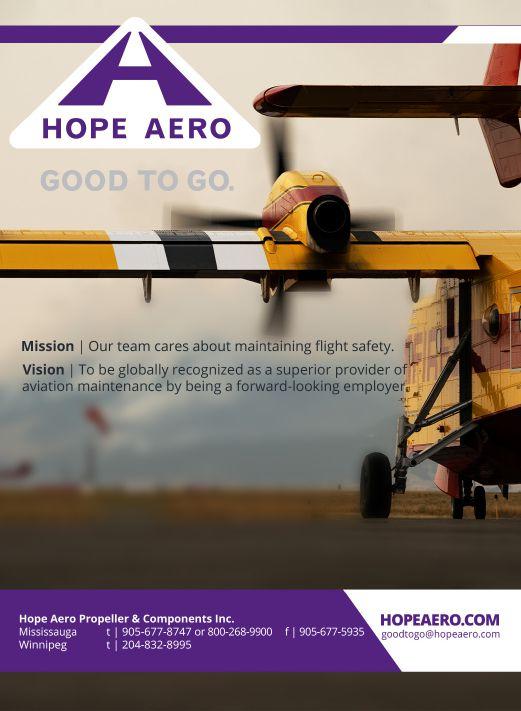

develop the next generation of aviation personnel in NSW. A minimum of two mechanical apprentices will be part of the aviation team, explains Coulson, providing them with the opportunity to gain hands-on experience with firefighting aircraft. Coulson Aviation recently became the first aviation firm approved by Transport Canada as an Approved Training Organization (ATO), allowing the company to train technician candidates who can earn while they learn. The plan is to expand this model into NSW, explains Coulson, attracting new technicians and training them specifically for the utility aviation environment and to continually develop a well-trained workforce.
During the 2022-23 bushfire season, RFS aircraft managed by Coulson Aviation completed over 340 missions and rescued 113 people. The RFS’s 737 ‘Marie Bashir’ was deployed 41 times, dropping more than 600,000 litres of retardant. The fleet also supports other emergency services such as flood rescues. | W
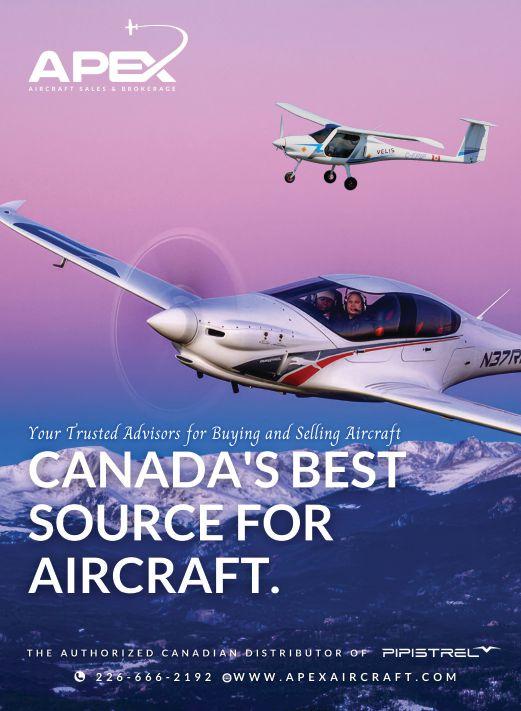

By David Carr |
At an undisclosed location, likely in Canada, the future of sustainable business aviation is taking shape. The aviation industry is working on the next revolutionary leap. A technological game changer that will lead to a 10 to 15 per cent reduction in fuel burn and emissions. Similar to how a Pratt & Whitney geared turbofan engine and a revolutionary, resin-infused advanced composite wing, developed by Bombardier’s then Shorts Brothers plant in Belfast, paved the way for the most efficient and versatile airplane in its class. Now the Airbus A220.
A new-generation narrow-body replacement for the Airbus A320 and Boeing 737 families of jetliners will not be launched using existing wing and propulsion technologies. (Although Boeing will have to use existing technology for a new mid-market airplane to replace an ageing global fleet of 757, 767 and A310 airplanes.)
Part stingray in appearance, the Bombardier EcoJet is a family of scalable demonstrators to test the performance characteristics of Blended Wing-Body (BWB) design. Blending the wing seamlessly with the fuselage produces a single lift service that lowers drag and will significantly reduce fuel-burn compared with conventional jets. Cutting emissions by up to 50 per cent.
The research into EcoJet technologies began 15 years ago in concept. Bombardier began the first phase of testing with a small-scale model of a BWB aircraft featuring a 2.5-metre wingspan. A second phase of testing launched in 2022, using a model more than double the wingspan of the first test vehicle, representing approximately 16 per cent of a large business jet. Earlier this year, Bombardier announced the University of Victoria Centre for Aerospace Research and British Columbia’s SME Quaternion Aerospace as early partners in the EcoJet project.
Data collected from each test phase will shape the development of the next fleet of test vehicles. But don’t expect Bombardier to come out with a clean sheet design before the end of the decade. No manufacturer has reached that point and
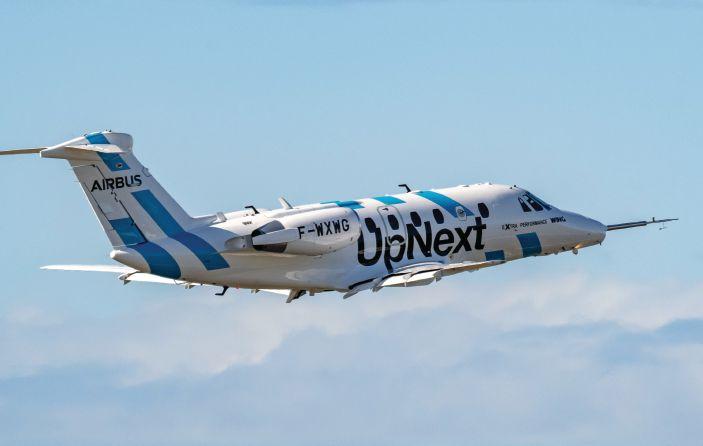
The targeted wingspan of the eXtra Performance Wing from Airbus will be approximately 52 metres, compared with an A320 wingspan of 35.8 metres.
Bombardier notes the flight-testing program involving its BWB designed vehicles will be held over multiple years to generate increasingly precise data in representative environments.
The hottest wing about to enter service belongs to the Boeing 777x. A third-generation variant of the world’s best-selling widebody. Expected in late 2025 or 2026. Using the 787 as a template, the 777x features a 71.8 metre, all composite wing, 6.9 metres longer than the existing tripleseven, with foldable wing tips (FWT) that reduce the length of the wing to the original size.
A first for commercial aviation, foldable wings have been a feature on advanced military aircraft needed to park in small spaces on an aircraft carrier. Boeing had first offered foldable wing tips on the original 777. More than 30 years later, it is an idea whose time has come.
Similar to a blended wing, the new wing gives the 777x greater lift, reducing fuel
burn by an estimated 10 per cent. The foldable wing tip enables the aircraft to use airport gates that can already support an existing 777. On the ground, the 777 will taxi to the runway with wings folded. It will take 20 seconds to extend and lock the wing tips into place.
In mid-August the launch of the 777x aircraft encountered another delay as Boeing discovered problems in a structural component between the engine and the plane’s wings in a test flight. The 777x program was launched in 2013 to build the world’s largest and most efficient twinengine jet, with seating for up to 426 and a 13,500 km range (both targeted for the 777-9 variant).
Boeing patented its foldable wing in the early-1990s. Airbus patented its own foldable wing in 2014 and is considering a hinged wing for its A320 replacement.
In September 2021, Airbus launched the eXtra Performance Wing project. The project seeks to develop a wing that can change shape and form during flight to maximize its aerodynamic efficiency. Last November, the eXtra Performance Wing project demonstrator, a modified Cessna Citation VII business jet, took off for the first time.
The eXtra Performance Wing design incorporates active control technologies, as well as physical changes to the wing structure. Airbus explains gust sensors on the front of the aircraft will register changes in turbulence, triggering relevant adjustments to the control surfaces of the wing.
“This system is designed to be entirely automatic,” says Sebastien Blanc, eXtra Performance Wing Technical Director.
“The eXtra Performance Wing technologies, which change the shape of the wing by mimicking a bird's feathers, will adjust automatically to maximise aerodynamic flow.”
The targeted wingspan of the eXtra Performance Wing will be approximately 52 metres, compared with an A320 wingspan of 35.8 metres. A one-third scale version of the eXtra Performance Wing will be attached to the Cessna and undergo ground testing later this year before first flights begin in 2025. Airbus notes the eXtra Performance Wing technologies could be applicable to any kind of aircraft and propulsion system.
It is estimated that narrow-body aircraft account for half of commercial aircraft emissions produced today. Producing wings that are longer, leaner and lighter will be one of the aviation industry’s biggest opportunities to improve fuel
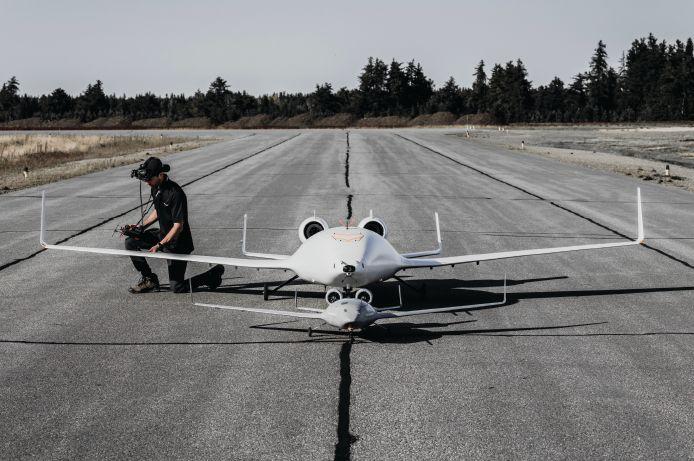
efficiency, reduce emissions and achieve the industry’s ICAO-led target of net zero carbon emissions by 2050.
“The drive to be leaders of sustainability makes us do things differently. While aerospace has been fantastic at becoming more efficient decade by decade, the bold promise we have made to sustainability,

and the technology we need to get there drives us in a different direction,” said Steve McCullough, senior vice president of engineering and product development at Bombardier. | W


By John Gradek |
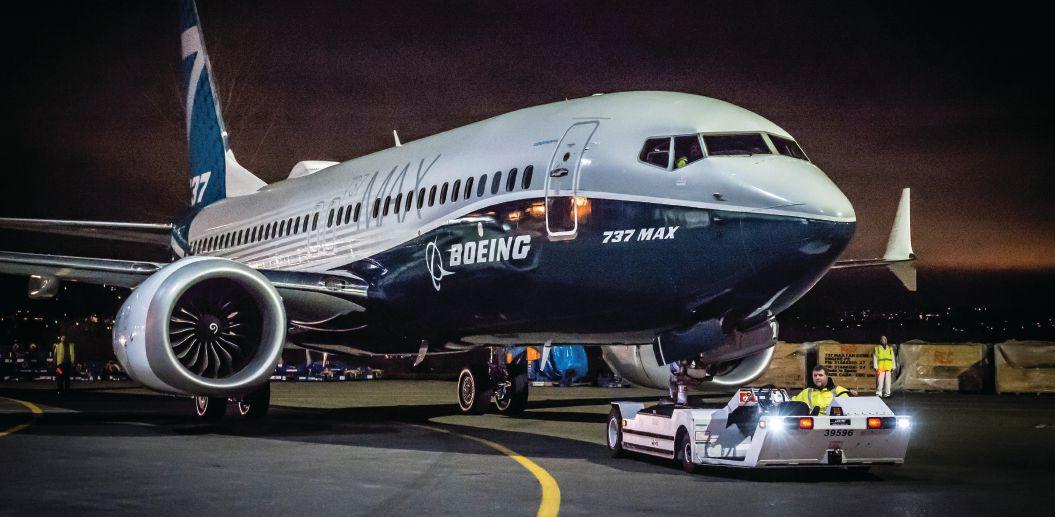
If ever there was a need to exemplify the term annus horribilis in the annals of corporate history, 2024 and the Boeing Company would be the perfect match. And the year is not even over yet.
Seven days at the beginning of July have seen Boeing face a number of issues. The United States Federal Aviation Administration (FAA) issued an airworthiness directive on July 8 requiring airlines that operate the Boeing 737 Next Generation and the 737 MAX to inspect each aircraft’s oxygen generator system for restraining strap failures within the next five months.
This directive followed multiple reports of passenger oxygen generators shifting out of position – an issue that could prevent passengers from receiving oxygen during an emergency.
Additionally, Boeing has agreed to plead guilty to a fraud charge resulting from failing to disclose critical design elements to regulators responsible for certifying the 737 MAX aircraft into commercial service.
The U.S. Department of Justice revealed that Boeing agreed to the plea deal on July 7, after the government determined Boeing violated an agreement that had protected it from prosecution.
The plea deal is the culmination of a threeyear review process initiated in 2021. Boeing was ordered to demonstrate changes in its operating and production practices that contributed to the 2018 Lion Air and 2019 Ethiopian Airlines crashes, which involved 737 MAX aircraft and resulted in 346 fatalities.
It is estimated that Boeing has lost US$60 billion in sales because of these crashes, and it has seen its profitability reduced by more than US$32 billion since 2019. Its debt increased to close to US$50 billion. Beyond the financial impact, the crashes have also had an emotional toll on the families of the victims.
If the plea deal is approved by a federal judge and comes into effect, it will result in
additional fines and expenses for the company. (A final decisions on the deal had not been rendered before press time.) Boeing will be fined an additional US$243.6 million and be required to invest at least US$455 million in compliance and safety programs.
Lawyers representing some of the families have been pressing for a rejection of this Department of Justice plea deal, stating that: “The only way to enact meaningful change at Boeing would be to take action that affects its bottom line, which would mean imposing larger fines and more severe consequences.”
The U.S. Justice Department in a court filing on August 14 defended the plea deal saying it lacks evidence to prosecute the aircraft manufacturing company for more serious crimes.
If this challenge by the victim’s families is successful and the plea deal is rejected, it will result in a public trial that will require Boeing staff to testify about their roles in deceiving FAA regulators about a
flight-control system that was implicated in the crashes. The financial implications for Boeing in such a trial have been estimated to exceed US$25 billion.
The aggregate of these events will yet take more of a toll on Boeing. Political and regulatory discussions have highlighted the frustration with Boeing executives who have continued to apologize and promise change.
Whistleblowers have presented a number of failings with Boeing’s assembly practices that have prevented potential safety issues from being addressed while aircraft are on the assembly line.
It is startlingly evident that these failings could impact the safe and reliable operation of the final product. The culprits in these failings have been identified sporadically as the Boeing culture, the Boeing leadership style and the management performance measures in place.
Much has been published about Boeing leadership having morphed from engineering- and quality-focused mindsets to one focused on economics and financial performance.
Boeing at the end of July named Robert Ortberg as its new CEO. He is a 35-year aerospace veteran, who previously led
Rockwell Collins and helped drive the powerhouse RTX. He also comes to Boeing with an engineering background.
Can Boeing overcome its current challenges and regain its reputation as a winning corporation? One that its employees, clients and the travelling public can count on to produce commercial aircraft that are safe, comfortable and sustainable?
To do so, the world needs to trust the Boeing brand once again, a trust that was developed through decades of producing aircraft that customers held in high regard for quality and engineering design.
Even with the arrival of a new CEO, the board of directors at Boeing needs to stand before the governance mirror and ask themselves if they have met their entrusted oversight responsibilities.
It should not come as a surprise that many of Boeing’s directors are long-serving in their roles, bearing responsibility for the missteps taken by management in the recent past.
Recent legal challenges aimed at limiting board members’ liability in instances of corporate mismanagement have failed in the U.S., with the courts reinforcing the need for directors to be aware of corporate
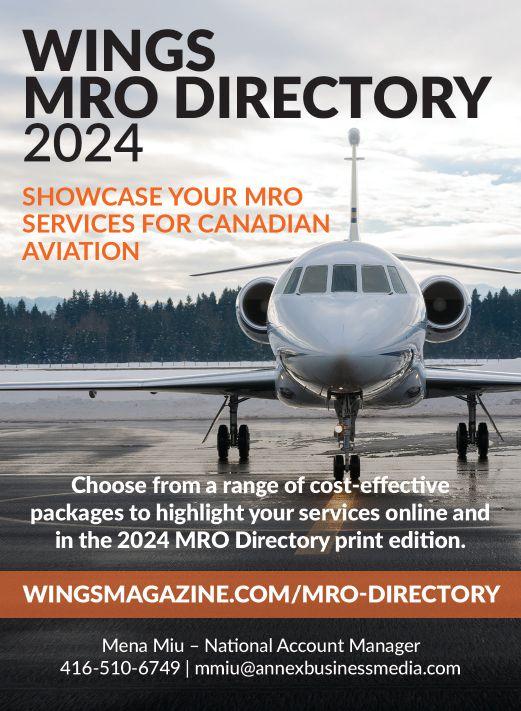
malpractices and take action to remedy such instances.
All this raises an important question: Is there a risk to Canadian airlines and Boeing’s Canadian supply chain members resulting from this litany of issues?
If the plea agreement is permitted to come into effect, Boeing will be identified as an organization convicted of a felony. As such, it would be subject to a U.S. statute that prevents defence contractors who have been convicted of certain felonies from winning future defence contracts.
Given the nature of Boeing’s presence in both commercial aviation and defence, it seems unlikely this felony conviction will hinder Boeing’s relationships with suppliers and customers. The world needs Boeing to return to its fabled engineering, safety and quality roots. Global aviation depends on the reliability of major aircraft manufacturers. The clock is ticking and Boeing cannot make promises. Actions and results are needed – and needed quickly. | W
John Gradek is Program Coordinator, Supply Network and Aviation Management, at McGill University. This article was originally published by The Conversation.


BY PHIL LIGHTSTONE
In Canada there are 189 Flight Training Units and 2,603 flight instructors, some of which are not active.
Canadian Flyers (CF), a Flight Training Unit (FTU) operating from the Kawartha Lakes Municipal Airport, CNF4, recently announced that its operations were put on pause after more than 30 years. In November 2023, CF moved its base of operations from the Toronto Buttonville Municipal Airport, CYKZ, with the closing of the airport. The City of Lindsay enthusiastically welcomed CF to the airport, which is roughly a one-and-a-half-hour drive from
Toronto. CF had planned on building out a facility to allow the flight school to operate a state-of-the-art training environment.
Canadian FTUs face obstacles every day, such as flight instructor shortages, airlines hiring flight instructors, impacts of weather to flight operations, skyrocketed aircraft acquisition costs, escalating 100LL fuel costs, aircraft maintenance engineer (AME) shortages, airport restrictions caused by noise concerns from neighbours, supply chain issues, lack of support from all levels of government, travel time to the airport, the list can seem like it is endless.
In January 2024, Immigration, Refugees and Citizenship Canada (IRCC) announced that it had made changes to the foreign student program, reducing the number of Student Permits (also known as Student Visas) to a maximum of 360,000, a decrease of 35 per cent from 2023. To implement the change, as of January 22, 2024, every study permit application submitted to the IRCC will also require an attestation letter from a province or territory. Provinces and territories were expected to establish a process for issuing attestation letters to students by no later than March 31, 2024. Attestation letters are another bureaucratic issue, where once issued to a specific student, it cannot be re-assigned to a different student if the student does not start the flight training program – possibly because of funding issues, change of career aspirations, etc. This

has the impact of reducing the number international students at any given FTU.
In the January 2024, the IRCC also announced that starting September 1, 2024, international students who begin a study program that is part of a curriculum licensing arrangement will no longer be eligible for a post graduation work permit (PGWP) upon graduation. In other words, they will have to leave Canada at the conclusion of their study program. However, in June 2024 it appears that the policy was revised allowing a few special cases, including flight school graduates. To be eligible for a PGWP, a graduate must comply with one of the following: Completed a flight training course at a designated learning institution (DLI) training centre and now have a Canadian commercial pilot’s license; or have or are in the process of getting an instructor’s rating and a job offer as a flight instructor from a DLI flight training centre.
Canadian Aviation College (CAC), operating out of Pitt Meadows, B.C., has over 150 students in its program, with 70 per cent foreign students. Pitt Meadows is a thriving flight training environment with 13 FTUs operating on the aerodrome. Iris Challoner, Administrative Officer, CAC, is concerned about two changes: International students can work 20 hours per week, but study must be prioritized over their jobs; and current changes to post graduation work permits. CAC hires a lot of students as flight instructors gaining hours required for airlines.
“International students must leave Canada once they get a flight instructor rating, but if the same student graduated with a
post doctorate or master’s degrees they can stay and work,” Challoner explains. “This seems discriminatory and has the potential to cripple Canada’s aviation industry. I have spoken with our MP lobbying the need for exceptions to IRCC’s policies in the aviation sector.”
Clearly the federal government has been listening and collaborating with aviation industry leaders. This is an issue for Canadian FTUs, as they rely on foreign students who have obtained their Instructor’s Rating, to stay in Canada, ideally working in their FTU and training the next generation of pilots. Canadian citizens who acquire a frozen ATPL will quickly move on to charter companies or airlines, as they gain more hours. Typically, instructors will work at a FTU for one and half years before moving on.
CF, as part of Ontario’s College and University organization, has a robust international ATPL program with many foreign students being trained. Its current pipeline included 40 registered international students. Combined with the disruption to Canadian students living in the Greater Toronto Area caused by the move from Buttonville to Lindsay, these factors impacted the long-term goals of CF.
“I want to make it clear that placing our operations on hold was not caused by any financial difficulties,” Dario Matrundola, President of Canadian Flyers, says. “Canadian Flyers has no debt, owns all of its aircraft, simulators and other assets. The cancellation of our international student’s Visas has put a hold on both the construction of new facilities at the Kawartha Lakes
Airport and our flight training program.” CF has 30 students enrolled in its flight training program, down from 150 students when they operated out of Buttonville.
Flight training in the Greater Toronto Area has been under attack with lease cancellations, training restrictions, noise constraints and airport closures. The recent announcement of the City of Oshawa and Canadian Flight Academy (CFA) settlement of its legal dispute resulting in CFA’s agreement to cease flight operations at CYOO by December 31, 2025, is another example of Canadian flight training being impacted by “Not in My Back Yard” syndrome.
Andy Nureddin, Chair of the Canadian Business Aviation Association (CBAA), fully understands the political environment which Flight Training Units operate under. He sees many if not most Canadian flight schools fixated on training student pilots with the goal of acquiring frozen ATPLs and then sending them off to the airlines. For an individual focused on the business aviation and general aviation side of the industry, there is a lack of flight training capacity, especially in the Greater Toronto Area (GTA).
“The City of Oshawa/CFA legal disputes, the recent closures of the Buttonville and Downsview airports, and the cancellation of international student Visas by the Federal Government are more examples of all levels of Canadian governments’ lack of support and vision to the aviation industry,” Nureddin says. “At the end of the day, no one is better served by these impacts. This results in a lose-lose outcome lessening Canada’s aviation industry, not unlike the impact of the Luxury Tax on Canadian business aviation. The federal government needs to strategically fix its immigration policies, but not tactically cancel all international aviation student visas.”
The Honourable Marc Miller, Minister of Immigration, Refugees and Citizenship stated: “International students are vital to Canada and enrich our communities. As such, we have an obligation to ensure that they have access to the resources they need for an enriching academic experience. In Canada, today, this isn’t always the case. Today, we are announcing additional measures to protect a system that has become so lucrative that it has opened a path for its abuse. Enough is enough. Through the decisive measures announced today, we are striking the right balance for Canada and ensuring the integrity of our immigration system while setting students up for the success they hope for.”
Chinook Helicopters Ltd. has 50 employees, 28 aircraft and trains roughly 200 students. In a typical year, 30 per cent of these aspiring aviators are international

students. Cathy Press, CEO of Chinook Helicopters, has seen increasing challenges in government policy changes at both the federal and B.C. provincial government levels. Different ministries affecting policy are not aware of the potential impact they are creating and how it will affect companies like hers. The bulk of CHL’s revenue comes from training, although the company also generates revenue from the sale and maintenance of helicopters. CHL has been lobbying the B.C. government for many years to have the current support for student aid changed. B.C. typically provides repayable student loans of $5,500 (per student), while the same form of Alberta student aid provides funding of up to $70,000.
“In our business, student repayment of loans is at a much higher level than typical college and university loans,” Press explains. “To help overcome changing B.C. student aid policies, the ministry would need to recognize that aviation has a pilot, instructor and AME shortage. The provincial ministry that oversees student aid wants statistics. They say that all industries are short and why is this industry any different.
“Adding to the issue, Transport Canada is challenged with providing accurate statistics that really show the shortages in our sector,” Press continues “Industry insiders feel the impacts of the shortage every day. This latest policy change from the IRCC will have long term implications which we are just beginning to see. I truly believe people who work
for Transport Canada want to see Canada be the best on the world stage. However, until all the ministries can work together to have aviation be recognized as an area that needs skilled workers, we will continue to have limited or fragmented support from the government.”
Funding is critical for an international student. IRCC’s website indicates that the annual cost of living for a single student is $20,635. The cost of the Student Permit is $150. Flight training from “zero to hero” is $117,189 (based on CAC’s current training fees inclusive of taxes) and typically takes two years to complete. This requires an international student to have access to roughly $158,459. The flight training costs may be higher based upon several factors, including the student’s capabilities, weather, instructor and aircraft availability and others. Additional fees may include fuel surcharges and hourly rate increases. Cost of travel to the airport is another cost not considered. The challenges and constraints faced by the FTUs impact not only student pilots on a commercial career path, but also general aviation (GA) or recreational pilots. With limited FTU capacity, Canadians are finding it more difficult to find a FTU within a reasonable driving distance from their home who are willing to take on GA student pilots. Historically, GA student pilots found weather and time to be the largest limiting factors (to successfully completing the program). In the last five years, access
to a FTU, instructor and aircraft availability are new constraints limiting the increase in Canadian licensed pilots.
For FTUs, provisional and federal constraints will impact their top line revenue over the next few years. This will cause some FTUs to reduce operating costs, through reducing their training fleet and laying off staff. Trickle down economics will see local airports impacted through a decline in fuel sales, aircraft hangarage and parking revenue, as well as a reduction in AMO revenue. As Canada faces a housing shortage, international student pilots might be challenged with finding accommodation. Some FTUs have purchased residential properties (near their airport) to create housing for students. The impact could cause the FTU to divest their properties, while facing a capital gains taxation impact. With roughly 9,000 student pilots in the system, the impact to the Canadian economy of the reduction of international students could be as high as $349 million and a taxation loss of $45 million (during their study period).
Historically, we have found the support from all levels of government can change on a dime, based upon bad things happening, like a world war. World War II is a great example of when government and private sector came together to build airports, aircraft and train copious amounts of pilots. Canadian aviation today needs new structures to build new pipelines. | W
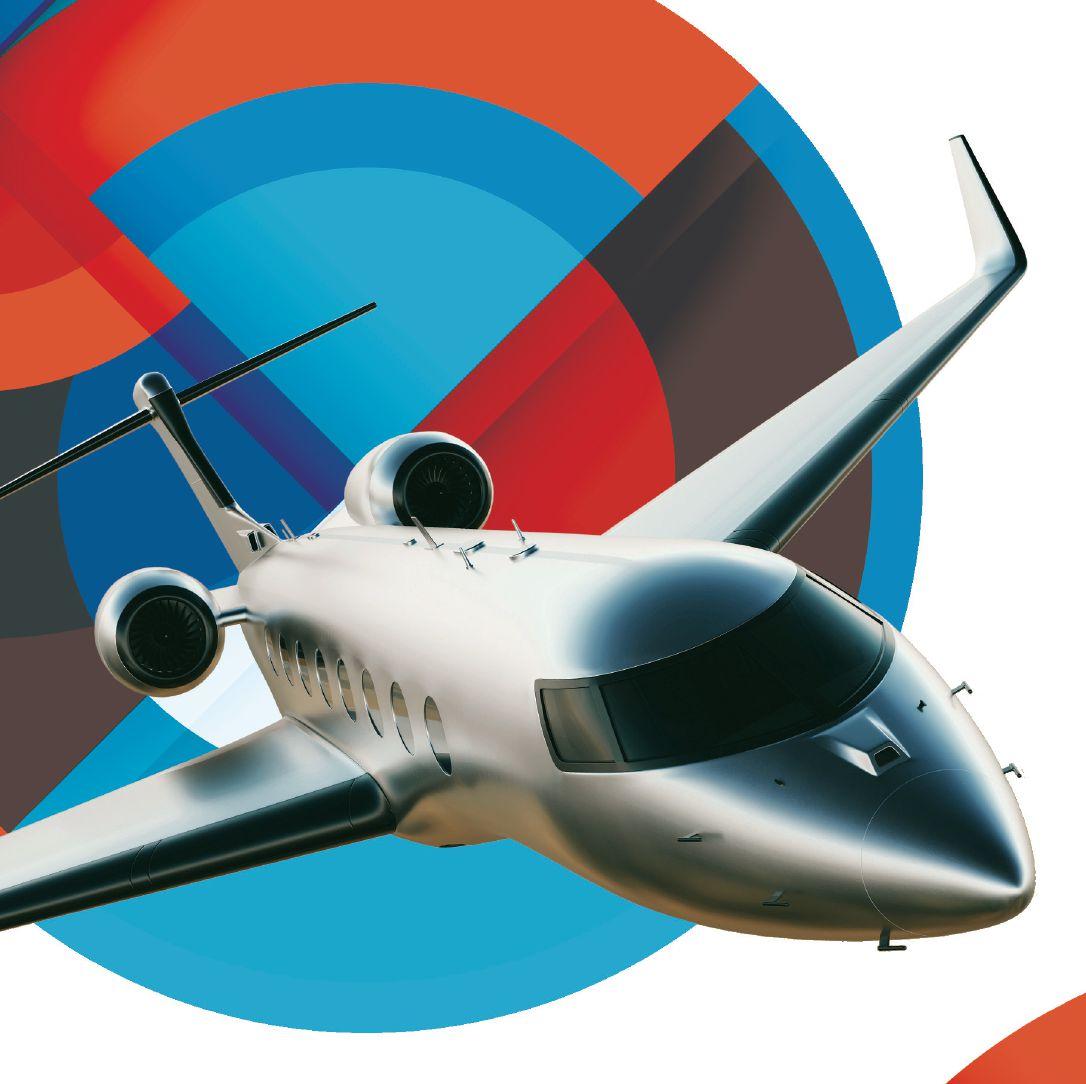


BY JON ROBINSON
Bill Blair, Canada’s Minister of National Defence, on May 29, 2024, at the CANSEC defence trade show in Ottawa, Ont., outlined the details of a 25-year, $11.2 billion contract being awarded to SkyAlyne Canada Limited Partnership for the Future Aircrew Training program. It is part of the largest recapitalization of the Royal Canadian Air Force (RCAF) since the Second World War. Since 2022 alone, the Government of Canada has finalized the procurement or upgrade of approximately 140 new aircraft for the RCAF, highlighted by F-35 future fighters and P-8A Poseidon multimission aircraft.
Under the new Future Aircrew Training (FAcT) program contract, Canada will acquire more than 70 training aircraft in total, split into five fleets. This includes fleets of Grob G120TP, Pilatus PC-21, Beechcraft King Air 260, Airbus Helicopters H135, and De Havilland Dash 8-400 aircraft equipped with a mission training system in the cabin. The contract also includes classroom instruction, simulator and flight training, as well as numerous on-site support activities for prospective RCAF Pilots, Air Combat Systems Officers, and Airborne Electronic Sensor Operators. Training under this new contract will continue to take place at key locations in Saskatchewan and Manitoba, building on an existing foundation, and is expected to be operational in 2029.
Initial aircrew training for Pilots, Air Combat System Officers, and Airborne Electronic Sensor Operators will be conducted at 15 Wing Moose Jaw, Saskatchewan, Portage la Prairie, Manitoba, and 402 Squadron, at 17 Wing Winnipeg, Manitoba. FAcT is a next generation training program following what is currently provided through in-house delivery by the RCAF, as well as two separate contracts for the NATO Flying Training in
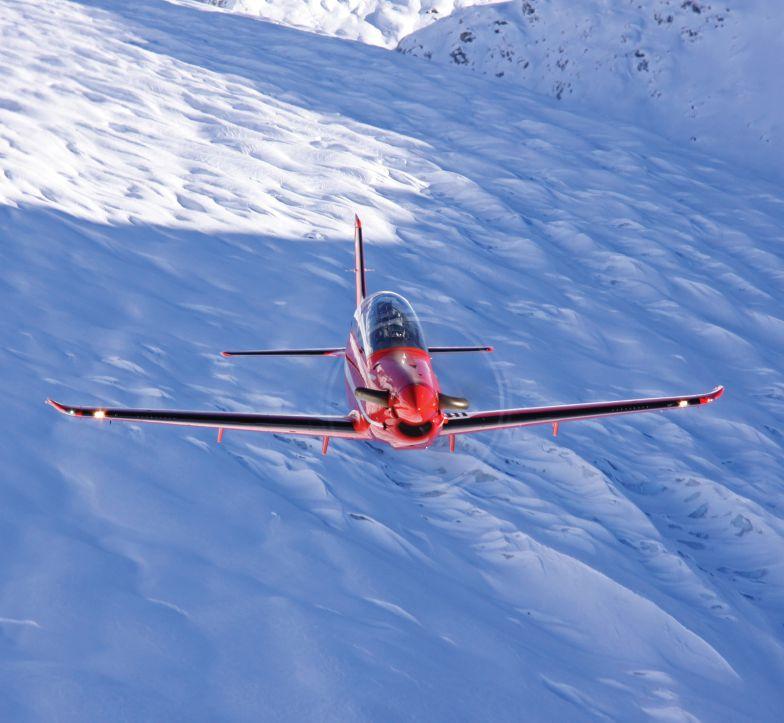
Canada (operated by CAE Inc.) and Contracted Flying Training and Support (operated by KF Aerospace) programs. The FAcT program, explains the Government of Canada, has the potential to create or maintain 3,400 jobs and contribute $405 million annually into Canada’s gross domestic product over a 25-year period.
SkyAlyne was officially formed in 2018 as a partnership between CAE and KF Aerospace, two Canadian aviation, training, and defence leaders. The partnership was built to jointly bid on FAcT, which can be traced back to 2013, before the scope of the procurement was initially outlined in 2016. SkyAlyne in 2023 was named the preferred bidder and in May 2024 was officially
signed as the contractor. Wings spoke with SkyAlyne’s General Manager, Kevin Lemke, at CANSEC on the day of the official contract award.
A native of Longueil, Québec, Lemke joined the Canadian Armed Forces in 1983 and is a graduate of the Royal Military College of Canada (Mechanical Engineering) and the Georgia Institute of Technology (Masters of Science in Material Engineering). He served in the RCAF for more than 20 years where he completed operational tours as an Aerospace Engineering Officer, including service as the Lead Engineer for Failure Analysis, and as the CC130 fleet Aircraft Engineering Officer. After his military career, Lemke began as a Project Manager at
Cascade Aerospace and was later promoted to Director of Maintenance and Engineering at Heli-One, and Vice President of Production at IMP Aerospace. Lemke returned to Cascade Aerospace and held the role of Executive Vice President and Chief Operating Officer before his appointment as General Manager of SkyAlyne in April 2024.
How long had the SkyAlyne team worked on FAcT before this official contract award?
Kevin Lemke: For the team, this is about a seven-year venture. FAcT was announced as a program back in 2017. The shareholders of SkyAlyne, KF Aerospace and CAE, who each [currently run] two of the sites that are going to be used for future aircrew training, looked at [the procurement structure] when it first came out, and asked, ‘Do we compete against each other or what’s the best solution?’ They felt a Team Canada solution was the right answer and formed a joint venture as partners. They said ‘we’ll build an independent, standalone corporation with us as the shareholders and we’ll build a team around it’ and bid on FAcT.
The Canadian government procurement cycle can be lengthy and this is, I believe, the largest services contract the Government of Canada has ever awarded. By its nature, it’s very large, it’s very complex. The government has a lot to do on its side to ensure they have due diligence and fairness in the process. It’s been a massive undertaking by the owners of SkyAlyne for years. Our bid was submitted last year, followed by a preferred bidder announcement in June 2023. Then there was a lot of further due diligence after that, before Canada could get to the point of contract signing.
What is the next step under this daunting 25-year contract award?
In one sense it’s daunting, but in another sense it’s actually what we need as industry, because this is a massive investment for the country and even just to do the bid it’s a massive investment for industry. You need that duration and volume to allow you to build an efficient and costeffective solution for Canada and not to piecemeal it [through, for example] a fouryear program, and then hope you can get

an extension. In terms of a procurement concept, I think this is what industry was looking for and, as the Minister said today [May 29], we are seeking to work in a collaborative manner and it is these kinds of programs that allow it to happen. It does mean, however, that there is a lot to do.
We have to buy five fleets of aircraft. We have to build all kinds of hangars. We have to build all kinds of simulators. We have to build new courseware that’s a modern simulation-based, virtual training environment that leads to flight in the aircraft. There is a big, big block of work to be done upfront here. The good news is the two existing programs have four to five years worth of life left on them. We have a lot to do in those five years, but it’ll allow Canada to keep training their people in the current system and then, hopefully, we can make a seamless transition into the new system over a four- to five-year period, which gives us a bit of runway to do the heavy lifting now that we’re on contract.
How will SkyAlyne leverage the legacy training systems?
For the Air Force they are critical, because you can’t go three, four years without creating aircrew. We are recapitalizing as a nation and lots of new platforms need lots of new pilots and operators, and so it’s critical for the Air Force to have that capability. Experience was the advantage that allowed SkyAlyne to win. We have the incumbent contractors and shareholders. We understood the business intimately. We knew where the challenges were. We knew where
it was possible to improve and to make that investment, because there is a 25-year tale behind it.
I think the industry largely viewed this as the Power Team when the promotion came out. Having that background allows us to really take the best of what both companies and both programs have done and try to replicate that everywhere. Take the advantages and where there are weaknesses in one spot offset them with the strengths in another spot; and build a best-in-breed training system for Canada.
Beyond the legacy systems, where does SkyAlyne start in building out FAcT?
As part of the procurement, you needed to come in with a lot of the planning done and a lot of the solution defined; and that was how Canada made their selection. A training-needs analysis for a major aircrew training program is a massive undertaking. What are we going to teach them? How are we going to teach them? And it maps down into how many airplanes you need, what hangers you need, what simulators you need. That’s all been done as part of the bid.
We’re at the point now where we need to refine and execute on the plans that were already created during the bid. They’ve already basically accepted the plans by accepting us, but we’ll work hand in hand with the government to validate the exact details. The plan is to be on contract, buying airplanes within the first year, to be breaking ground for the infrastructure
within the first 18 months. The planning is already largely in place and it serves as the guidelines and milestones schedule for everything we’re going to do.
Where will the infrastructure investment begin?
At all three sites… At 17 Wing in Winnipeg, new training facilities. There are hangars, training facilities, barracks, etcetera. In 15 Wing Moose Jaw, there’s major investment in Moose Jaw and similarly in Southport, which was formerly Portage Air Base. There’s new hangars, new training facility, new mess and accommodations being done there.
The actual building portion isn’t part of the $11 billion that was announced, but we have a 10 per cent design in place. This has notionally been accepted. It’s going to get final review and then we’ll do the detailed design. Once that is defined, then there will be a competition for the actual construction element at all three sites later.
Why go with the Pilatus PC-21?
Because it is relatively new, it’s also very relevant. It has some of the same attributes as the Texans, which we call the Harvard IIs in Canada. But it’s 25, 30 or 40 years –I'm not sure exactly how much – newer in core design and certification. [The PC-21]
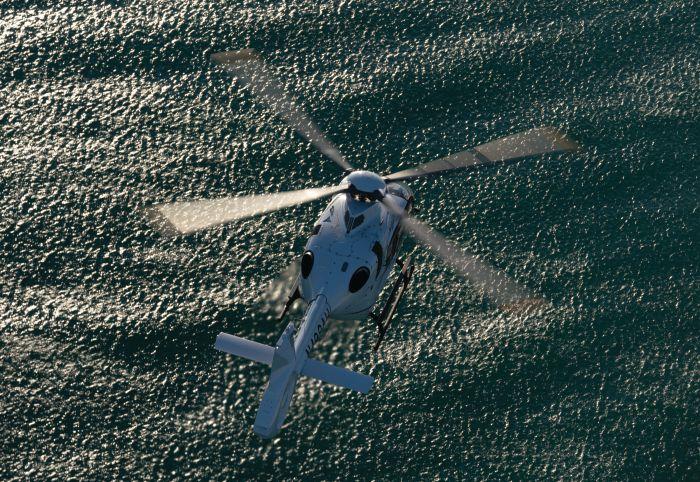
The Airbus H135 will form the future backbone of advanced helicopter training for the Canadian Armed Forces under the Future Aircrew Training program.
has a similar engine, but significantly more power, so it’s able to do more. And it’s a very, very capable platform in terms of aerodynamics, the power-to-weight ratios, everything else. It serves as a very good advanced trainer for Canadian pilots.
For over 35 years, AeroCourse has been a leader in advanced aviation training in Canada. We provide advanced aviation training and develop and publish manuals and workbooks both hard copy and digital to assist pilots gain the knowledge they require for their IFR and ATPL. We offer IFR and ATPL seminars, IFR online courses, and hold specific advanced aviation courses inconjunction with airlines, colleges and flight schools. Our instructors are professional pilots and flight examiners with thousands of hours experience. We pride ourselves on high quality materials and training. Results guaranteed!.
flying for Canada’s top airlines. They are dynamic and enthusiastic. Having exceptional instructors, ensures a productive learning environment and contributes to our student’s success
What does this contract mean for SkyAlyne’s foundation companies, CAE and KF Aerospace?
I think both companies view this as almost an existential program. CAE are absolutely world leaders in aircrew training, but if



How significant is this program for Canada in terms of Industrial and Technological Benefits?
Because so much of this is Canadian companies, a lot of that is hard to streamline. KF and CAE are Canadian, but we are buying over a billion dollars worth of tin, so there’s slowdowns on that. This is also among the first major contracts for Canada with a requirement for a substantial Indigenous Participation Plan based on elements like meaningful employment, subcontracting, skills development and training, and apprenticeship program opportunities, so it’s going to be a model.
Basically, excluding the main infrastructure, ground-based training, and aircraft costs, there is a requirement within the contract for us to ensure that five per cent of the work – five per cent of the dollar value – is generated through Indigenousowned businesses. This is a way to achieve reconciliation, by economic participation and partnerships. We’re going to be among the first major programs in the government where this is in place. We’re going to be ground-breaking. It’s a tremendously interesting opportunity, personally for me, for the corporation, and for the country. There is a lot of work ahead.
How fundamental is this Canadian solution for the domestic aviation industry?
Maybe I’m being a little too aspirational, but I’ve already sort of introduced [our marketing team] to a quote when Roosevelt during World War II called Canada, “The Aerodrome of Democracy.” The
Commonwealth training program was one of the great contributions Canada made to World War II and it is the legacy that we come from. That is how we want to grow, to reestablish and really define ourselves as a nation of leaders in aircrew training.
What excites you most about your role with SkyAlyne?
This is a career pinnacle opportunity. It really is. I’m starting essentially right as the announcement was made. I’m going to help lead two shareholders that come from different parts of the country, with
different cultures, even if they are well aligned. We have to turn this into one business entity that operates effectively and serves the shareholders very well.
We need to bring other subcontractors in and get contracts with them. We have to build the next generation aircrew training system for the RCAF. We’re going to work in the Joint Management Office, a facility that will house SkyAlyne, plus all of the RCAF people and the PSPC people in the same room. I think it’s the first contract that’s really called for a formal collaboration model – what an opportunity. | W


KF Aerospace is Canada’s largest MROs and has been serving the aviation industry for more than 54 years. The B.C. company now holds approximately 1,200 employees of which 550 are AMEs, including licensed and unlicensed team members, as well as apprentices.
BY PHIL LIGHTSTONE
Most sectors of aviation, from business and general aviation and to commercial and aerospace industries, over the past decade have been facing many challenges. The 2020 Covid pandemic highlighted a labour issue in the aviation sector, which is not news. Flight training units (FTU) have seen a reduction in experience flight instructors (FI), with the average FI tenure now at one and half years. The federal government’s changes to Canadian foreign student policy and the
reduction of foreign student permits by 35 per cent, is causing a ripple effect, creating financial and labour constraints for both FTUs and mission critical Maintenance, Repair and Overhaul (MRO) facilities and Approved Maintenance Organizations (AMO). Air crew shortages is an ongoing issue. Inflation, labour shortages and supply chain logistics constraints are impacting the MRO/AMOs in North America. For the purposes of this article, we are lumping all certified maintenance shops, Aircraft Maintenance Engineers (AME), and apprentices into the common term MRO.
In the U.S., there are 357,903 (2022 data) certified Mechanics and Repairmen (A&P), with 9,875 new certificates issued in 2022. The FAA reports that general aviation and Part 135 aircraft in 2021 totalled 209,195 fixed- and rotary-wing aircraft. The stats on the surface suggest that there
are 1.7 mechanics per aircraft. Well, like most stats, the devil is in the details. The 357,903 number represents total issued certificates as opposed to those mechanics who are working. In 2021, there were 3,133 MRO businesses in the U.S. That does not include sole proprietors working out of a small hanger, the back of their truck or the aircraft owner’s location. The US Bureau of Labor Statistics (UBLS) reports that there are a total of 134,070 Aircraft Mechanics and Technicians (AMT) and 20,200 Avionics Technicians as of May 2022 (totalling 154,270). UBLS explains “about 13,100 openings for aircraft and avionics equipment mechanics and technicians are projected each year, on average, over the decade. Many of those openings are expected to result from the need to replace workers who transfer to different occupations or exit the labour force, such as to retire.”
Transport Canada reports that in Canada

(spring 2024 data) there are 16,380 AMEs, which does not include apprentices, and 856 AMO/MROs. Note that Transport Canada does not keep records on the number of apprentices, nor records of whether AMEs are working or retired. On the other hand, Stats Canada reports: 17,850 AMEM; 7,100 AME-E; and 13,100 AME-S, totalling 38,050 people. Innovation, Science and Economic Development Canada (ISED), in its summer 2024 State of Canada’s Aerospace Industry Report found that Canada’s aerospace manufacturing industry revenues reached 97 per cent of pre-pandemic levels in 2023 and predicts an increase to 117 per cent in 2025. Aerospace MRO activities in 2023 contributed $4.2 billion to GDP, $8 billion in revenue and 31,000 jobs.
Current Canadian national AME wages see a low of $22 to a high of $49 per hour. This includes provincial numbers
for Ontario at $23 and $47; Alberta at $20 and $52.50; and British Columbia at $21.98 and $47.18. Comparable trades: automotive has a low of $17.24 and a high of $42; heavy duty machinery with a low of $21 and a high of $50. Industry leaders such as Air Canada pay an AME Class 5 $42.05 per hour, with an annual adjustment of $0.80 per hour. Based upon a conservative estimate, an Air Canada AME 5 would earn between $92,000 to $102,000 per annum. But apprentice wages are much lower reaching between $19 and $24 per hour. Most Canadian provinces, however, do not recognize aviation apprentices as skilled trades and, as such, do not qualify for subsidies and grants.
“One of our concerns is that 50 per cent of graduates are earning their AME license, and 50 per cent of those who start in one of six approved Ontario training institutions will graduate,” Louis Anderson, President,
Aircraft Maintenance Engineers Association of Ontario, says. “Typically, Ontario educational institutions prefer a student failure rate below 30 per cent. The industry is concerned about the caliber of graduates and the AME Association is trying to help improve the employability skills of these new entrants to the industry through professional development opportunities and mentoring programs.”
The Canadian Council for Aviation & Aerospace’s Labour Market Information Report states: “The industry also has a growing need for experienced aircraft maintenance engineers. It is projected that the industry will need a minimum of 5,300 new aircraft mechanics by 2025 to keep up with growth and retirements. Aviationspecific college programs graduate approximately 600 maintenance technicians per year. Of these, approximately 77 per cent go on to work in the industry; however, there
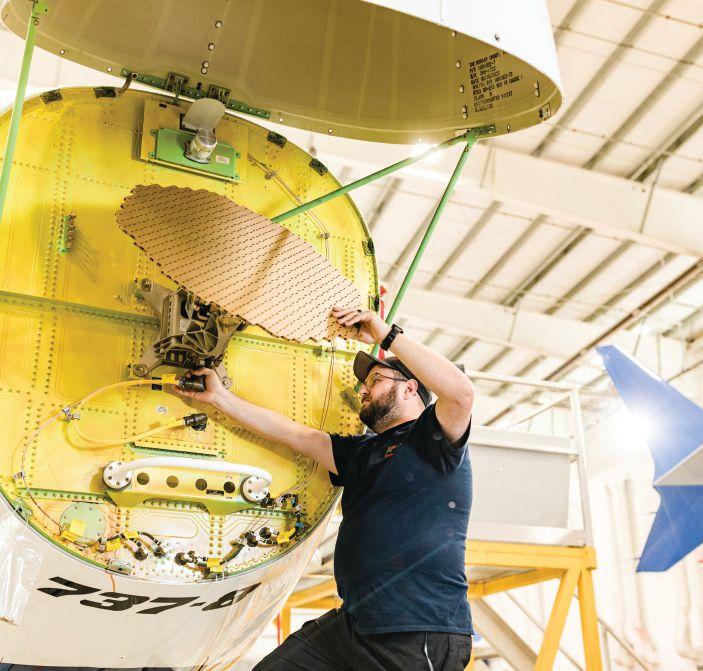

have been examples of other industries snapping up the majority of a graduating class, as they have sought out transferable skills. Lack of apprenticeships in aviationspecific occupations is seen as a barrier to attracting students into the industry.
“Only Manitoba offers traditional apprenticeship programs for the aviation industry with gas turbine repair and overhaul technician and the aviation maintenance journeyperson (AMJ),” continues the Canadian Council for Aviation report. “Aerospace manufacturing competes with other industries for skilled workers and employs skilled trades apprentices, with the top four being electrician, millwright, metal worker and machinist. Industry sees a need for more apprenticeships, coops and internships.”
KF Aerospace (KFA), one of Canada’s largest MROs, has been serving the aviation industry for more than 54 years with roughly 1,200 employees of which 550 are AMEs (licensed, unlicensed and apprentices). Additionally, they have 25 inhouse aerospace engineers, with plans to double this number. KFA employees 178 apprentices and more than 50 Aircraft Service Technicians. Key to the Kelowna, B.C. based company’s success is its working environment and culture, which promotes greater tenure of its staff. Fifteen per cent of KFA’s staff have more than 20 years of tenure, with some reaching 50-plus years. The average tenure of its technical staff is 10 years, with the long service of many of their technical employees creating a multigenerational workforce. During the pandemic, KFA was able to retain 85 per cent of its technical staff.
“Despite the challenges, we weathered the pandemic without significant layoffs, which was both the right thing to do and allowed us to quickly respond when normal operations resumed,” Grant Stevens, Chief Corporate Services Officer for KFA, explains. One element of the company’s labour success is fair compensation. AMEs are compensated hourly, with semi-annual increases as an apprentice and annual wage increases as a licensed AME. Typical work shifts are four days on with 10 hour shifts and shift rotations allowing for extended breaks.
KFA allows banked time or paid overtime and shift trades. The company offers what is typically described as a total rewards package, including industry competitive wages, health and dental benefits, a pension program, a personal spending account, a tool allowance program, vacation in the first year, and in-house cafes in Kelowna and Hamilton, Ont. Recently, KFA opened a childcare centre in Kelowna. To further enhance the KFA value
proposition, an annual bonus program was implemented, called “Barry Bucks”, named after founder Barry Lapointe, sharing a portion of profits equally among eligible staff. Over the past 24 years, KFA has distributed more than $40 million to its employees. KFA completes 1,000,000 maintenance hours on over 300 projects annually.
KFA reports that there is not only a gap in the number of AMEs needed, but also a talent gap. Long serving employees with immense knowledge are being replaced by new workers. KFA supports local colleges and engages with the public through career fairs, advertising, and high school events. On a national level, the company advocates for policies that make it easier to bring skilled workers into the country and help them gain permanent residency.
“The Temporary Foreign Worker program has been beneficial, but shifting regulations create uncertainty,” Stevens says. “We need the government to make it easier for skilled workers to join and grow our industry.” The competition for skilled trades is fierce across all industries, and aerospace is no exception. Canada does not produce enough skilled AMEs to meet the demand, exacerbated by the pandemic, retirement of experienced AMEs and their hiring by expanding airlines. This shortage poses a significant risk to the growth and stability of the industry.
KFA has found that the demand for MRO support has rebounded beyond preCovid levels as the airlines ramp up and return aircraft to service, resulting in KFA experiencing very high demand for the quality engineering and repairs it delivers. They could easily expand by 10 to 15 per cent annually if not for staffing shortages. “We are highly innovative, investing in public colleges and universities, increasing in-house training, and supporting one of the largest apprenticeship programs,” Stevens says. “We look worldwide for skilled AMEs and aerospace engineers and offer excellent pay and benefits.”
KFA reports: “Government policies and practices have a direct impact on our operations. The lack of commitment to aerospace on a national level – in terms of funding and immigration – and the fact that our industry is still not recognized as facing a skills shortage, are significant challenges. Despite these obstacles, nearly 35 per cent of our work is international, contributing to the GDP, while operating domestically to the benefit of Canadian industry and communities.”
Mike Busch, President of Savvy Aviation, during his EAA Webinar Booted Out of Annual commented about the state of

the nation of the A&P and MRO industry. Busch reports: “Some shops are booking their GA customer’s annual inspections one year out; some shops have a three month lead time for pre-purchase inspections; and some factory rebuilt engines can take nine months for delivery.” Mike’s webinar discussed a situation whereby an unlicensed shop manager was making decisions contrary to the advice of the licensed A&P and the desires of the customer. Essentially “bullying” the aircraft owner into an unneeded and unwanted engine overhaul. With the aircraft left in pieces, unflyable and removed from the hanger, the owner was put into a tight spot.
Fortunately, a compassionate FAA Flight Standards District Office Inspector came to the owner’s rescue. Interestingly, the FAA sees this circumstance as a business issue and not a regulatory issue. A contributing factor to Busch’s client’s circumstances came from a non-technical, non-licensed shop manager making technical decisions. Typically, shop managers have a technical background and experience moving through the ranks beginning as an A&P apprentice. With a shortage of licensed A&Ps, will this become a trend and how will aircraft owners navigate this change? “The problem with filling the A&P gap begins with how shops bill for work, using a
time and materials approach, essentially fixing everything that they see (to avoid future liability],” Busch says. “This drives repairs which may not need to be required [just yet].
“At the same time, A&P wages are much lower than in other industries, typically at US$30 per hour and with apprentices at much lower starting wages and shop rates as low as US$80 per hour, Busch continues. “A paradigm shift is required to sustain the industry. A Minimalist Maintenance Model combined with fixed-rate billing [like an automobile shop] will have the impact of increasing salaries, while reducing an aircraft owner’s total cost of maintenance.”
Narrowing the AME and apprentice gap begins with outreach to high schools, compensation and provincial support. The challenge requires cooperation of guidance councillors and executing outreach programs directly to students. An AME with more than 35 years of experience, currently residing in Ontario, with experience operating in Northern Canada, who wishes to remain anonymous summed it up: “Aviation maintenance is a career that the apprentices must have a burning desire to achieve. It’s a challenging environment that requires an apprentice to find an experienced AME to be their mentor, guiding them on their career path.” | W
TOP FBO IN CANADA 2024
Fast Air Jet Centre, YWG
HUB FBO, YHU
Gateway Aviation, YQG
TOP FBO IN WESTERN CANADA (BC, AB, YK, NWT)
Skyservice Business Aviation, YVR
Skyservice Business Aviation, YYC
Sunwest Aviation, YYC
Million Air, YYC
Airside Flight Services, YEG
TOP FBO IN CENTRAL CANADA (SK, MB, NT)
Fast Air Jet Centre, YWG
Kreos Aviation, YQR
Kreos Aviation, YXE Avflight, YWG
RISING STAR AWARD
FBO with the largest number of new votes
Skyservice Business Aviation, YVR
TOP FBO IN ONTARIO
Gateway Aviation Windsor, YQG
Skyservice Midfield, YYZ
Execaire Aviation/SkyCharter, YYZ
Chartright Air Group, YKF
Skyservice South, YYZ
4,801
Number of total votes in 2024
TOP FBO IN ATLANTIC CANADA (NB, NL, NS, PEI)
Execaire Halifax, YHZ
Celtic Air Services, YPD
Gateway Facilities Halifax YHZ
Irving FBO, YYT
Gander Aviation, YQX
TOP FBO IN QUEBEC HUB FBO, YHU
LUX FBO, YHU
Skyservice Business Aviation, YUL Avjet, YQB
AFS Exécutif, YQB
COAST
BY JON ROBINSON
he 2024 Top Fixed Base Operator in Canada survey conducted by Wings and Helicopters received 4,801 responses, covering more than 35 facilities, in an open voting system through the months of April, May, June and July. In addition to naming their favourite Fixed Base Operator
(FBO) in Canada, which also determines leaders across five regions, participants in the annual survey were asked five questions to provide insight into the business and private aviation sector.
Fast Air Jet Centre based at Winnipeg James Armstrong Richardson International, YWG, received the most votes across all
five Canadian regions to earn its spot as Canada’s Top FBO for the third straight year. Founded in 1995, Fast Air is ideally situated in the middle of North America and serves as a focal point for one of Canada’s top aviation and aerospace regions. The company has been expanding its unique approach to business and private
aviation over the past couple of years (see page 30, People, Planet and Profit).
The recent expansion of Skyservice Business Aviation was also on full display in this year’s Top FBO survey with five of its facilities earning honours, most notably with its Vancouver facility winning the Rising Star Award, recognizing the location to receive the largest vote increase year over year. One respondent commented: “Skyservice YVR is the best FBO I have ever seen.” The facility earned top honours in Western Canada; Gateway Aviation Windsor, YQG, placed first in Ontario for the second straight year; HUB FBO housed in Saint Hubert (Montreal Metropolitan Airport) was first in the province of Quebec; and Execaire Halifax, YHZ, topped Atlantic Canada. In addition to its national recognition, Fast Air was first in the central region.
When asked for what type of travel do you most often use an FBO (allowing respondents to select more than one category), Business Aviation represented the majority of responses at 53.7 per cent, followed by Air Crew at 40.7, Personal at 19.2 per cent, and Maintenance/Technician at 14.9 per cent. Government travel represented the fewest responses in the category at 5.9 per cent.
The return of Transborder travel is evident from the survey as 59.9 per cent of respondents indicated the U.S. was a destination in 2024, second behind Domestic travel at 68.8 per cent (again allowing participants to chose more than one category). Last year, Domestic travel dominated the sector at 72.6 per cent while Transborder flight in 2023 was in play for 36.7 per cent of respondents. International travel also picked up in 2024 as a category of note for 28.5 per cent of respondents versus 21.6 per cent in 2023. These numbers match a 2024 rebound in aviation as airports around the world begin to reach, and in some cases beat, pre-pandemic numbers.
Respondents were asked into which area would you invest to improve your aircraft performance and use. Cabin Comfort was first reaching 41.3 per cent, followed by Sustainable Aviation Fuel at 34.2 per cent and Speed at 25.8 per cent.
When asked into which area they would prefer their FBO to invest, Facility came in first at 42.83 per cent, followed by Customer Service at 25.4 per cent, and Transborder Access at 20.2 per cent. International Access was a close fourth at 18.2 per cent, followed in order of most votes by Maintenance, Aircraft Availability, and Onboard Communications, among a range of other investment preferences. | W

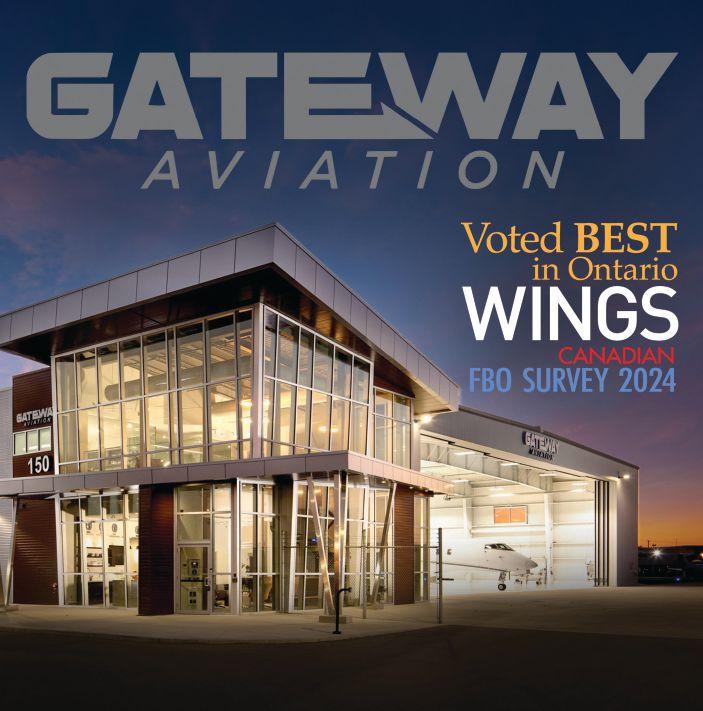

By Phil Lightstone
Headquartered at the Winnipeg Richardson International Airport, Fast Air is one of Canada’s fastest growing air charter operators of turboprop and business-jet aircraft. Fast Air Group of Companies operates several divisions that include two FBOs, air charter services out of three locations, aircraft management, maintenance and a medevac division (Vanguard Air Care).
As a part of this larger campus, Fast Air Jet Centre Winnipeg has access to 140,000 square feet of heated hangars, maintenance and aircraft management support for its clients. This enables the Jet Centre to accommodate all types of aircraft, from private single-engine planes to large corporate jets, and even Boeing and Airbus aircraft for professional sports teams.
Regardless of size, every aircraft receives the same red-carpet experience at Fast Air. The company also provides air charter services in Toronto at the Billy Bishop Downtown Island Airport and now in Abbotsford, B.C. The company has over 30 aircraft in its fleet, approximately 200 employees and fuels an average of 1,200 planes per month.
Fast Air was founded in 1995 by Dylan Fast, who began his career as a commercial pilot and soon realized that there was a need for air charter service to meet the requirements of business and governments in Manitoba and beyond. His mantra from the outset has been “better, not bigger”, which focuses team members on making sure that things are done to the best of their abilities and not to worry about growth. With a focus on quality, growth into other locations was a natural outcome.
In 2021, Fast Air began analyzing the needs of British Columbia’s lower mainland and found that there was an opportunity to grow its charter services that cater to local business aviation needs; essentially, to create a Vancouver Executive Airport at Abbotsford International Airport, CYXX, not unlike what Teterboro is to New York City or Van Nuys is to Los Angeles. Located less than an hour from Vancouver, CYXX allows Fast Air to offer competitive landing fees, lower land costs and faster turnarounds relative to Vancouver International, CYVR. In other words, smaller is better, faster and less expensive.
In 2022, Fast Air began offering air charter service at Abbotsford International, which soon after led to the construction of a new hangar and offices, totaling more than 20,000 square feet; and now the establishment of a full-service FBO.

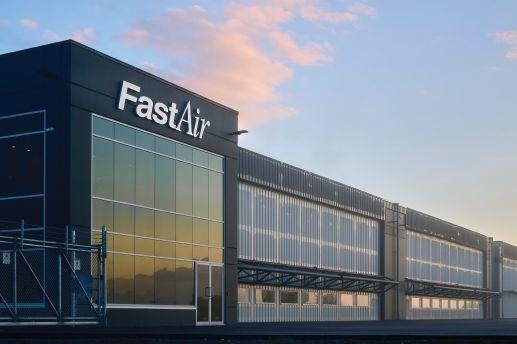
Fast Air is adding a Cessna CJ3 and Citation X (planned for the fourth quarter of 2024) to compliment its King Air 200 in Abbotsford, providing charter services to residents and businesses. The construction of the new facility was completed in the spring of 2024 and was built to standards supporting Fast Air’s environmental 2030 mandate of 100 per cent carbon neutral operations and waste reduction by 50 per cent.
With more than 4,000 square feet of office, lounge and lobby space, the new FBO at CYXX provides clients with a state-ofthe-art environment offering every amenity one could think of, including ultra-secure Wi-Fi access to ensure the data privacy and security of clients’ computers, tablets and smartphones.
“One of the most exciting parts of constructing a new private terminal is putting our focus on an incredibly enhanced experience for the traveller,” says Dylan Fast, President and CEO, Fast Air.
Fast Air’s success can be traced back to its culture of unrelenting customer service and employee satisfaction. “Expanding out West is an exciting step for Fast Air,” says Karlen Prendiville, Marketing and Business Development, Fast Air. “It allows us to bring our foundation of high standards of service and expertise to a broader clientele, ensuring that every client experiences the excellence we've built our reputation on.”
Fast Air’s culture is built upon three guiding principles: People; Planet; and Profit. Focusing on people ensures that the work environment delivers to the needs of the staff, clients,
vendors and partners. In 2024, a new gym was built in the Winnipeg facility to help promote the benefits of a healthy body and mind among Fast Air’s team members. Planet focuses on a commitment to being environmentally progressive and responsible. Profitability focuses on strategic investments which leverages the company’s People and Planet pillars. These include investments into aircraft which deliver better performance and drive competitive advantages; energy and process-efficient new hangars for growth; invest into company culture and training; and right sizing staff levels during lean economic periods.
Philanthropy is front and centre at Fast Air, with financial support of charities including iDE Canada and Surrey’s Mackie’s Place Youth Social House, among many others. In May 2023, Fast Air hosted a day of celebration and fundraiser at its new Abbotsford hangar, helping to raise over $25,000 for Mackie’s Place. iDE Canada creates income and livelihood opportunities in developing countries around the world, investing in local entrepreneurship, building businesses with a focus on agriculture and sanitation. iDE Canada will host a charity wine tasting at Fast Air Jet Centre Abbotsford in the fall.
Fast Air also sponsors Eagles Wings Flight School, a 100 per cent volunteer run charity providing aviation training to at-risk Indigenous youth and often opens its facility for youth focused tours. Investing in aviation’s future generations has, and will remain, a major focus for the company.
Fast Air’s focus on sustainability spotlights a reduction in its carbon footprint and a waste reduction by 50 per cent by 2030. To accomplish this, Fast Air has implemented several sustainable efforts, including LED lighting in all locations and replacing ICE operating tugs equipment when needed, such as ground power units. Leveraging a clean-slate design, the build of the new Abbotsford hangar used modern energy efficient technologies, smart building automation technologies and best practices. Their Carbon Reduction Plan has three phases: Phase 1, all operations are carbon neutral; Phase 2, all Fast Air aircraft become carbon neutral; and Phase 3, all client aircraft become carbon neutral. Fast Air’s managed aircraft service offering helps guide its clients to achieving these environmental goals. Treated as trusted advisors, Fast Air can guide its clients down an ecologically sound path, balancing clients’ needs with the needs of the planet.
Fast Air’s formula is simple, go beyond the call of duty and leave clients completely satisfied through a safe, professional and comfortable experience. This formula has been repeated for almost 30 years of service and puts the focus on every client who boards an aircraft as a special guest. For three years running, Fast Air has won Wings’ Top FBO in Canada Award. Dylan Fast, CEO and President of Fast Air commented: “I am very proud of Jackie, D’Arcy, Rob, Scott and the whole Fast Air Jet Centre team who have been recognized by the aviation community as the Top FBO in Canada,” Fast says. “I have had many messages from companies and aircrew over the years telling us about their great service experience, so I know this is well-deserved.”
Originating in Winnipeg brings a down-to-earth mentality to business aviation at Fast Air, which over the past 29 years has proven that its business model and ethics have allowed for growth. Relationship building, consistent quality and employee values have resulted in increasing profits, which Fast Air invests into its clients, employees and the planet. While its head office is in Winnipeg, Fast Air executives travel to Abbotsford and Toronto to ensure that the new teams are part of the company culture, delivering an inclusionary working environment. One can only wonder if further expansion is on their minds. Perhaps an Abbotsford model delivered into Eastern Canada?
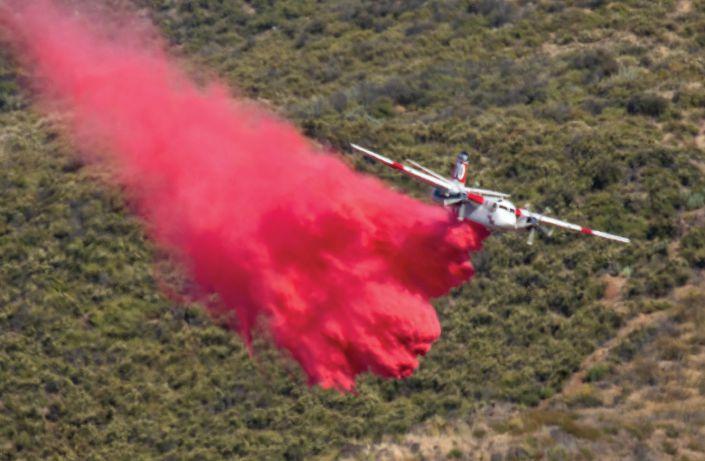
BY ERIC KENNEDY
Hundreds of firefighters from as far afield as Australia, New Zealand, Mexico and South Africa back in July were deployed to western Canada to help fight wildfires. Within the same timeframe, a major fire fueled by drought and wind damaged a third of the structures in the picturesque town of Jasper.
Australian fire managers arrived in Lac La Biche, Alta. while other experts from both Australia and New Zealand were deployed to British Columbia to assist with wildfires there. At the same time, more than 200 firefighters and two helicopters from Ontario headed to Alberta to lend a hand. But, why do these kinds of exchanges happen and how are they co-ordinated?
The answer to these questions provides some fascinating insights into both the dynamics of Canadian wildfires and the nuances of global disaster relief efforts.
Wildfire managers in Canada face a significant problem. In some years, a province
will experience massive wildfire activity, while in other years, very little will burn. In a year like 2023, B.C. burned an area more than five times the size of Prince Edward Islan. In 2011, however, the wildfires in the province burned less than three times the equivalent size of the city of Charlottetown.
This creates a “peak load problem.” Fire management agencies need to be able to manage the worst of years, but also risk being the target of criticism for being overstaffed or too expensive during quieter ones. Yet, staff need to be hired and trained, equipment needs to be purchased, and aircraft must be procured before the season even begins.
To solve the peak load problem, Canadian fire management relies on a system of mutual aid.
Fire agencies across Canada staff at a roughly appropriate level to the requirements of their average fire season and if a province experiences lower-than-average fire loads then they are able to lend personnel and equipment to those that may be experiencing higher than average fire
activity. This exchange is typically coordinated through a small but essential group of experts within the Canadian Interagency Forest Fire Centre (CIFFC) who coordinate potential exchanges between its members.
An exchange begins with the agency in need making a request. This request is transmitted to CIFFC, which looks for availability among the other members. If Alberta needs a waterbombing aircraft that Ontario is willing to share, for example, or if Nova Scotia requires incident management personnel that the Yukon can make available, then the CIFFC can help facilitate such efforts.
These exchanges are governed by the Canadian Interagency Mutual Aid Resources Sharing (MARS) agreement which addresses the legal issues, procedures and costs involved in these collaborative efforts. In making a request, the receiving agency agrees to repay the costs of these resources, and in offering to fulfill an order, the sending agency agrees to provide staff and equipment that are up to the standards of the MARS agreement.
CIFFC’s role in fighting wildfires in Canada is absolutely crucial. Not only does it move thousands of personnel and pieces of equipment per season, but it also helps to ensure firefighting infrastructure is in good working order outside of the fire season.
How do you ensure every hose in the country can connect to every pump, so that it can all be exchanged? How do you ensure that incident management teams will be able to slip into their role seamlessly and work well with counterparts across the country? CIFFC brings member agencies together year-round to negotiate these painstaking details so that pumps from Ontario coming off an airplane in Alberta can immediately be plugged into hoses from Manitoba by firefighters from Saskatchewan.
When Canadian resources are fully exhausted the provinces can also turn to CIFFC to broker international requests. This is done in much the same way: a request is made, CIFFC then seeks available resources from international partners and the requesting agency repays the costs.
Some patterns may emerge, such as a tendency to only bring incident managers from expensive destinations like Australia, while bringing more firefighters from closer locales like the United States and Mexico. Moreover, these international exchanges haven’t been without controversy, with recurring disputes around the relative wages paid to international partners being a common theme.
It is impossible to overstate the degree to which Canada depends on mutual aid – both
from within Canada and from around the world – to manage a country increasingly ravaged by wildfires. Fire managers routinely talk about the “Spirit of the MARS,” or the shared commitment in Canada to manage our fires together, and this collaborative spirit is, in many ways, our greatest asset in the fight against wildfires. That being said, the mutual aid system is also not without challenges that must be addressed. One challenge is climate change. As the wildfire seasons lengthen, it will
become more and more difficult to draw resources from the southern hemisphere. As fires drag into Australian autumns and emerge earlier in Canadian springs, it will become more difficult to rely other countries during their traditional quiet periods. Additionally, as the fire load rises across the whole country and entire season, it becomes harder to find resources in quiet times elsewhere within the country. These pressures mean that it’s critical for every member agency to continue to
increase their capacity as their fire load increases, rather than relying only on other provinces to backfill. The variability of the “peak load” problem will continue, but as the wildfire season grows, Canada’s provinces and territories will need to be prepared not just for their own needs but to be on hand to help their fellow Canadians.
Canada depends on mutual aid to manage its fire. Mutual aid, moreover, brings all sorts of other benefits.
Mutual aid in firefighting efforts builds trusted relationships and professional exchanges as operations collaborate across the country. The very practical exchange of learning, knowledge and experience beyond what a firefighter could ever hope to acquire working within their province alone is itself a huge asset to Canadian wildfire suppression efforts.
Confronting the challenge of a future in flames requires investing in the Spirit of the MARS and continuing to lean on mutual aid rather than attempting to go it alone. | W
Eric B. Kennedy is an Assistant Professor, Disaster and Emergency Management, York University, Toronto. This article was originally published by The Conversation.

A major Industry Networking Event not to be missed!
TUESDAY, NOVEMBER 5 TO THURSDAY, NOVEMBER 7 WESTIN
ATAC’s Canadian Aviation Conference and Tradeshow is the premier national gathering offering Canada’s best networking, learning, and sales opportunity for operators, suppliers, and government stakeholders involved in commercial aviation and flight training in Canada. For
our
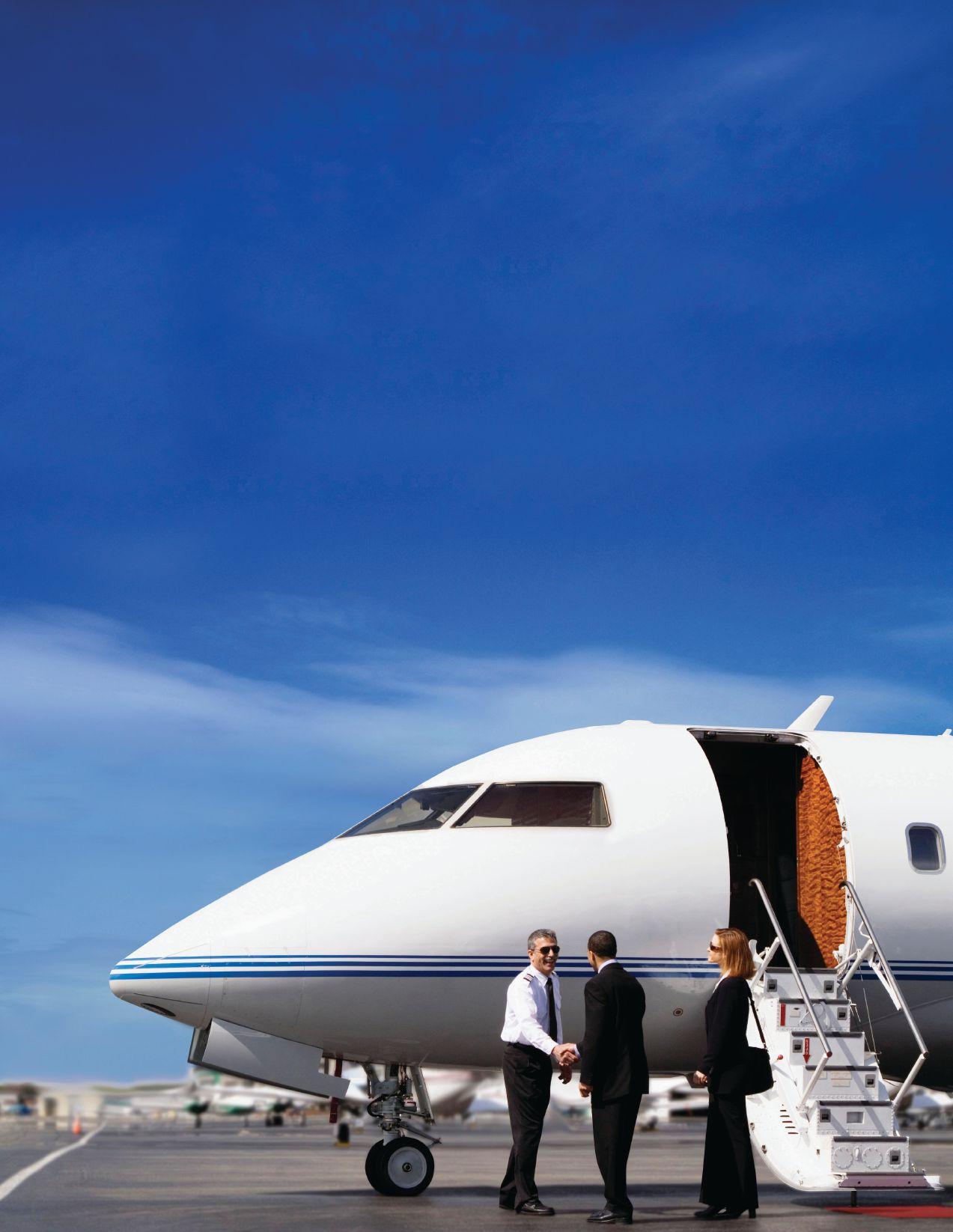
At Skyservice,TM providing comprehensive business aviation services to our clients has been our passion for nearly 40 years. Our award-winning — and expanding — network of fixed-base operations (FBOs) is recognized as the preferred gateway into the areas we serve across North America.
As we strive to deliver the best in world-class service, competitive fuel rates, and superior on-ground services, Skyservice is setting the standard for innovative, sustainable, and safe FBO services and operations. Learn more by contacting any of our convenient locations.
Skyservice FBO Network:
Canada
Calgary (CYYC)
Montreal (CYUL)
Ottawa (CYOW)
Toronto (CYYZ)
Vancouver (CYVR)
United States
Bend (KBDN)
Ft. Lauderdale (KFLL)*
Helena (KHLN)
Miami (KOPF)*
Napa (KAPC)
Redmond (KRDM)
Seattle (KBFI)

The ultimate resource of operators, services and technologies helping to lead wildfire suppression
The Aerial Firefighting Directory, presented by Wings and Helicopters, features key suppliers of aircraft, equipment and services for the aerial firefighting sector, as well as a range of rotary- and fixed-wing operators involved in emergency forestry services. Companies are positioned in categories based on their primary role, but often provide multiple services and functions for the sector.

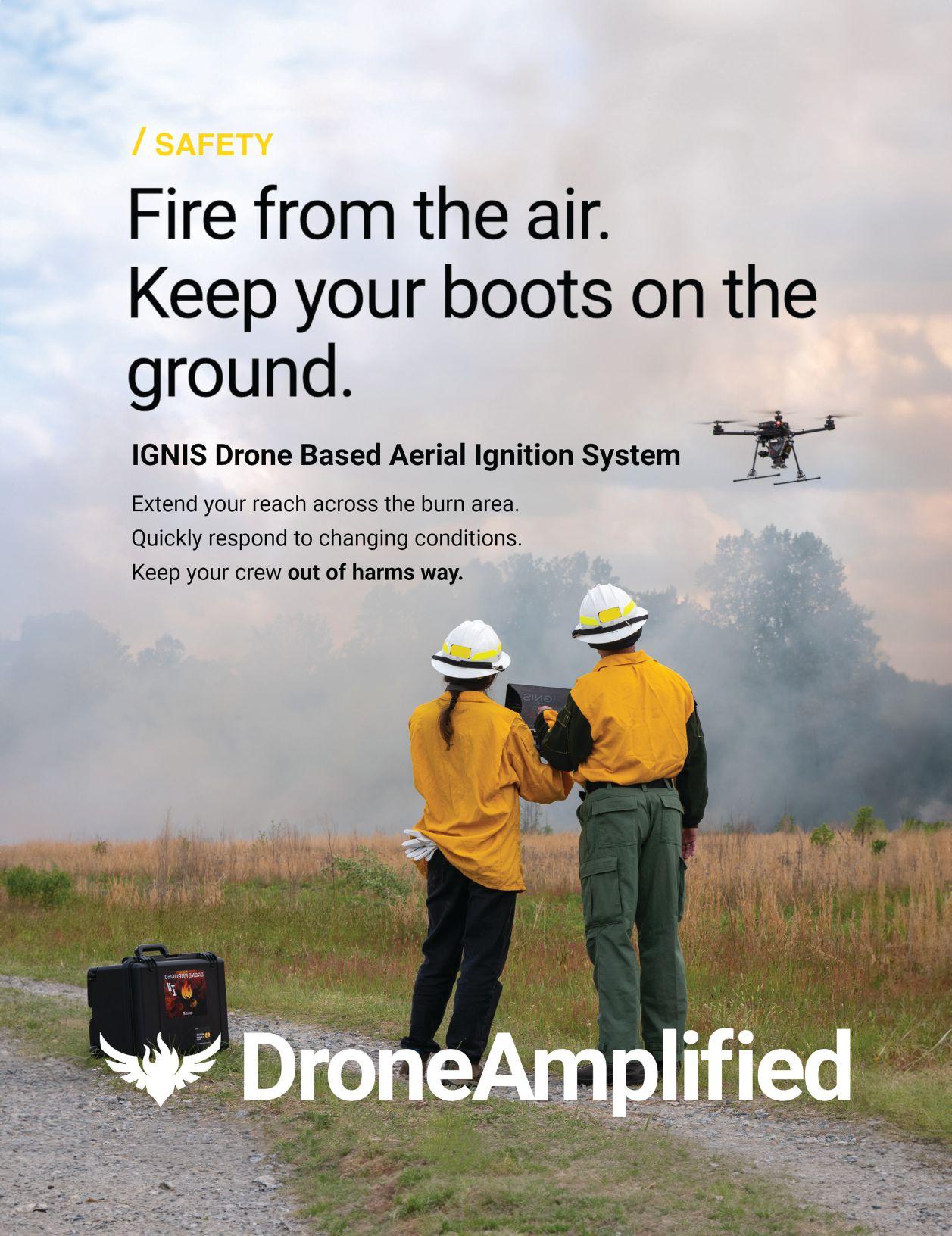
Olney, TX, airtractor.com
Tracing its root back to 1951 when founder Leland Snow designed his first ag airplane, Air Tractor today focuses its firefighting production around two aircraft, including: The AT-802F Initial Attack Firefighter, powered by powerful a Pratt & Whitney PT6A-67AG turbine, and the AT-802F Fire Boss Amphibious Scooper Air Tanker designed to deliver up to 14,000 gallons per hour for extended attack or ground support.
Fort Erie, ON, airbuscanada.ca
Airbus has been a proud member of Canada’s aerospace industry since 1984, as the operation celebrates 40 years of supporting Canadian customers in 2024. Headquartered in Fort Erie, Ontario, with a team of 300 employees, Airbus Helicopters Canada also has sales support in Montreal, Que., and a 24/7 customer service network in place coast to coast to support the fleet of more than 220 operators and 760-plus helicopters flying throughout Canada. Airbus Helicopters’ activities in Canada are focused in five primary areas: aircraft sales and deliveries, composite manufacturing, repair and overhaul, Supplement Type Certificates/options development, and support and services. In addition to the hundreds of Airbus helicopters already being used for firefighting, the full range of Airbus helicopters can be customized for fire suppression missions.
Mirabel, QC, bellflight.com/ca
Founded in 1986, Bell Textron Canada Ltd. has more than 1,500 Canadian employees and nearly 6,000 aircraft built in Canada. Bell in Canada has delivered more than 1,000 aircraft to Canadians. For more than 75 years, Bell has been a partner to public safety operators globally. The company fielded the world’s first fire helicopter and the world’s first public safety helicopter. Bell, a wholly owned subsidiary of Textron, is an industry-leading producer of commercial and military, manned and unmanned vertical-lift aircraft. It serves Bell customers in more than 120 countries.
Sandpoint, Idaho, kodiak.aero
Daher’s workhorse Kodiak aircraft family is operated in multi-mission applications that range from wildfire suppression and natural resources monitoring to public safety and humanitarian missions.
Produced in the Kodiak 100 version and its longer-fuselage Kodiak 900 variant, these high-wing aircraft are well tailored for fire suppression duties, bringing together the advantages of long loiter times, high stability at slow flight speeds, and the ability to take off and land from short/unimproved fields (as well as on water for the Kodiak 100). Both the Kodiak 100 and Kodiak 900 are equipped with modern avionics and have substantial useful load capacities. Among the worldwide operators are Bridger Aerospace, utilizing a fleet of Kodiak 100s for wildfire air attack and backcountry personnel transport; and North Carolina Forest Service’s Aviation Division, flying the Kodiak 100 as a “load aircraft” to deploy equipment and supplies.
Calgary, AB, dehavilland.com
In 1928, De Havilland Aircraft of Canada was created to build aircraft and train personnel for military missions in the defence of freedom. Over generations, the company evolved to lead Canadian aerospace innovation by designing and delivering over 5,000 aircraft that access remote communities, deliver aid, save lives, and safeguard communities the world over. De Havilland Canada launched the DHC-515 Firefighter program in March 2022. The DHC-515 builds on the history of the iconic Canadair CL-215 and CL-415 aircraft which have been a critical part of aerial firefighting fleets for over 50 years. From its aviation roots with legendary aircraft like the Beaver, Buffalo, Caribou and Otter; to today’s fleet of Dash 8s, Twin Otters and aerial firefighters that help protect and move people around the world, De Havilland Canada is dedicated to advancing its near100-year reputation of excellence in innovation, production, and customer support.
Portland, OR, ericksoninc.com
Erickson has been a world leader in heavy lift and aerial firefighting for more than 20 years. This includes its S-64 Air Crane Helitankers, equipped with fire suppression systems, which can drop more than 95,000 liters every hour.
Stratford, CT, lockheedmartin.com
Sikorsky, a Lockheed Martin company, is a world leader in helicopter design, manufacture, and service, with Canadian ties through its operation in Ottawa, ON. The new-generation S-70i FIREHAWK helicopter, using United Rotorcraft’s aerial firefighting system, features a 1,000-gallon
belly water tank, extended landing gear, 600-pound rescue hoist, and NVG compatible digital cockpit. The multi-role FIREHAWK can carry up to 13 firefighters and their gear, drop 1,000 gallons of water with precision, and perform at a dash speed of up to 140 knots.
Montreal, QC, dartaerospace.com
DART Aerospace designs and manufacturers market-certified solutions for the helicopter and aerospace industry. With a lineup of over 1,500 STCs and 5,000 products, DART offers a comprehensive portfolio of aftermarket products, aeronautical accessories, spare parts and services for civil and military operators, all major rotorcraft OEMs, completion centers and MRO facilities. DART's key products include aerial firefighting systems, emergency flotation systems, landing gear components, tools and ground support equipment, interior and exterior accessories, cargo expansion, windows and doors, cable cutters, engine and drive systems and external load equipment. DART has been designing, manufacturing, installing, testing, inspecting, repairing, and certifying products for more than 40 years. The company’s nine facilities are located around the world, including Canada, the U.S., Mexico, Amsterdam and the U.K.
South St. Paul, MN, firebossllc.com
Fire Boss LLC is the manufacturer of the Fire Boss water scooping system exclusively installed on the Air Tractor AT-802. The Fire Boss system combines airframe modifications, performance enhancements and a pair of Wipline 10000 amphibious waterscooping floats that enable the AT-802 to scoop up to 800 gallons in 15 seconds.
Noosaville, Australia, helitak.com.au
Helitak develops a range of systems for aerial firefighting, including its underbelly Fire Tank featuring a new design to allow a flexible bladder to expand while being filled; and then retract within its housing when empty. These tanks are custom built with a carrying capacity from 1,000 to 10,000 litres.
Bend, OR, kawakaviation.com
Kawak Aviation engineers and produces aerial firefighting products focusing on tanking systems, related pumps and
hydraulics. Its tank systems, refill pumps and hydraulic power solutions are leveraged by a range of platforms like Bell, Kaman and Firehawks.
Bend, OR, isolairinc.com
Isolair has been manufacturing helicopter systems for aerial firefighting, agricultural, and forest industries for more than 30 years with a range of certified equipment, from torches and buckets to tanking systems. Its Eliminator II Fire Fighting Systems, integrating tank, pump, doors and control, can be found working throughout the world.
Josephine, WI, recoil-usa.com
Established in 2008, Recoil Suppression Systems, a division of Recoil Aerospace, designs and manufacturers lightweight, carbon fibre composite Tsunami Wildland Fire Suppression tanks.
Longueuil, QC, prattwhitney.com
Founded in 1928, RTX’s Pratt & Whitney Canada is a world leader in the design, manufacture and servicing of turbofan engines for business jets, turboprop engines
that power regional commercial airlines and general aviation aircraft, turboshaft engines that power some of the world’s leading helicopters, and auxiliary power units (APUs). P&WC is headquartered in Longueuil, Quebec, and has facilities across Canada and around the world serving 16,000 customers who fly its 66,000 engines in service today. P&WC engines power a variety of aircraft that are used in firefighting, including a host of helicopters and the waterbombers from De Havilland Aircraft, Thrush and Air Tractor. The company’s Global Service Network has more than 55 owned and designated facilities around the world, with 100 Field Support Managers and 100 Mobile Repair Teams.
Delta, BC, sei-ind.com
SEI Industries introduced the original Bambi Bucket to the firefighting community in 1982. This lightweight, strong, and flexible firefighting bucket, with its relatively low-cost plug-and-play capability, promoted helicopter usage in wildfires. Today, SEI services over 90% of the world’s aerial firefighting water-bucket market. The Bambi Bucket is used in more than 115 countries and by over 1,000 helicopter operators.
St. Paul, MN, wipaire.com
For over 60 years, Wipaire has been engineering and manufacturing a full line of aircraft floats for all sizes of aircraft. In addition, Wipaire has engineered more than 100 Supplemental Type Certificated modifications, in addition to maintenance, avionics installation and repair, custom interior design and installation, and exterior paint refinishing. The company provides the Fire Boss as a water scooping system that is installed exclusively on the Air Tractor AT-802. The Fire Boss system combines several airframe modifications, aircraft performance enhancers, and a pair of Wipline 10000 series amphibious waterscooping floats that enable the AT-802 Single Engine Air Tanker to scoop up to 800 gallons in about 15 seconds. Over 150 Fire Boss systems are currently in operation throughout the world.
Lincoln, NE, droneamplified.com
Drone Amplified provides fire management technologies centered around integrations with Remotely Piloted Aerial Systems. Its


flagship drone-based aerial ignition technology, IGNIS is designed to provide firefighters with tools for efficiency, safety, and control during prescribed burn operations. With a track record of developing, deploying, and supporting hundreds of IGNIS systems, Drone Amplified is a leader in North American UAS integrations, holding a second location in New Jersey. Its expertise lies in seamlessly merging software, electrical components, and hardware to craft sophisticated payloads and systems tailored to specific operational needs.
Victoria, BC, indrorobotics.com
InDro Robotics is a Canadian R&D company specializing in aerial and ground robotics with a track record of working closely with first responders. InDro has created specialized products for use by firefighters and was called upon by the City of Kelowna to fly drone operations at the peak of the 2023 wildfires. InDro offers rapid response, thermal imaging, and photogrammetry. Its 5G capabilities enable beyond-visual-line-of-sight flight, while it collaborates with Transport Canada and NAV Canada for complex operations. InDro also provides drone detection services to ensure safety around fire zones,
offers RPAS training, and sells RPAS and robotic systems.
next1.tech
Founded in 2019, Next1 is a Canadian startup focused on tackling a range of environmental issues such as deforestation, forest fires and pollution. Its products include MAWA-1, described as an ultra-low-cost autonomous wildfire detection system that can detect wildfires as small as one square foot from an altitude of over 3,000 feet. The system can be installed on most light aircraft without any modifications. It is also compatible with most commercial drones. FireChaserV UAS is a fixed-wing drone designed from the ground up to detect, analyze and map wildfires. Thanks to its long endurance (two-plus hours) and range (50-plus km), the FireChaserV can analyze over 2,000 hectares per flight hour.
Dallas, TX, dallasavionics.com
Dallas Avionics was founded in 1973 as a wholesale distributor of aircraft avionics, test equipment and installation and pilot

supplies. Its team of professionals has an in-depth knowledge of the industry with over 60 years of quality service. The company holds ISO 001:2015 and AS9100D Quality Management System certifications.
Pitt Meadows, BC, maxcraft.ca Maxcraft Avionics is one of the largest avionics repair facilities in Canada and an authorized representative of more than 30 avionics brands. Maxcraft provides avionic services to all types of private and commercial aircraft, both rotary and fixed-wing. Its services include complete panel upgrades, installation, design, fabrication, STC approval, wire kit fabrication, and worldwide field support. Maxcraft holds an enormous inventory of serviceable avionics equipment available for sale, exchange or rent. Maxcraft is a Transport Canada approved maintenance organization and is recognized by both EASA and the FAA.
Tucson, Arizona, uasc.com
Universal Avionics, an Elbit Systems Company, develops commercial avionics systems offered as retrofit and forward-fit solutions for a range of aircraft. Its combined Enhanced Flight Vision Systems and
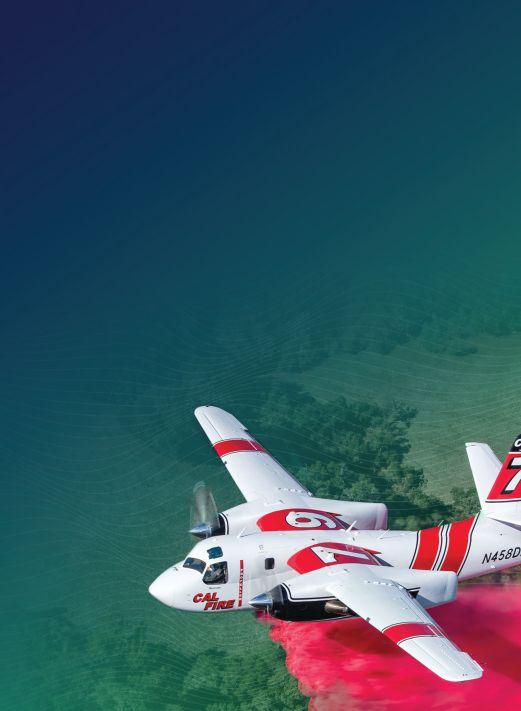
Head-Wearable/Helmet-Mounted Displays provide enhanced situational awareness during the aerial fire suppression.
Kelowna, BC, aem-corp.com
Anodyne Electronics Manufacturing Corp. (AEM) is a leader in the design, development, and manufacture of aircraft communication systems, loudspeaker systems, aerial firefighting and multi-mission radios, caution/warning panels, and airframe crack detection compliance sensors. AEM offers dedicated technical support and repair services to complement its product lines. AEM is a Transport Canada approved manufacturer and maintenance organization and holds EASA Part 145 Maintenance approval. AEM is a wholly owned subsidiary of Structural Monitoring Systems (SMS) Canada.
Nelson, New Zealand, flightcell.com
Flightcell International is a global producer of airborne integrated-mobile communications and manufacturers the DZMx as an
all-in-one Iridium and cellular solution for voice, data, and aircraft tracking. The DZMx is used by CAL FIRE, Erickson and Kestrel Aviation, among others, leveraging its built-in ATU and its broadband capabilities with fall-back to satellite. A range of bucket/tank configurations and reporting options are available.
Ottawa, ON, guardianmobility.com
Guardian Mobility develops technology and solutions to empower aircraft fleet managers and owner-operators with fundamental operational data for making timely decisions. Established in Ottawa in 2002, its flight tracking solutions include hardware, airtime, software, and support. The technology is leveraged for missioncritical environments like fire suppression, EMS, utilities, and law enforcement. Guardian Mobility supports aerial firefighting activities by providing telemetry information for aircraft, support vehicles, and personnel using Automated Flight Following (AFF) and Additional Telemetry Unit (ATU) technologies that enhance situational awareness and safety through near real-time location tracking and reporting of water suppression activities. The Guardian Mobility ATU solution provides a complete
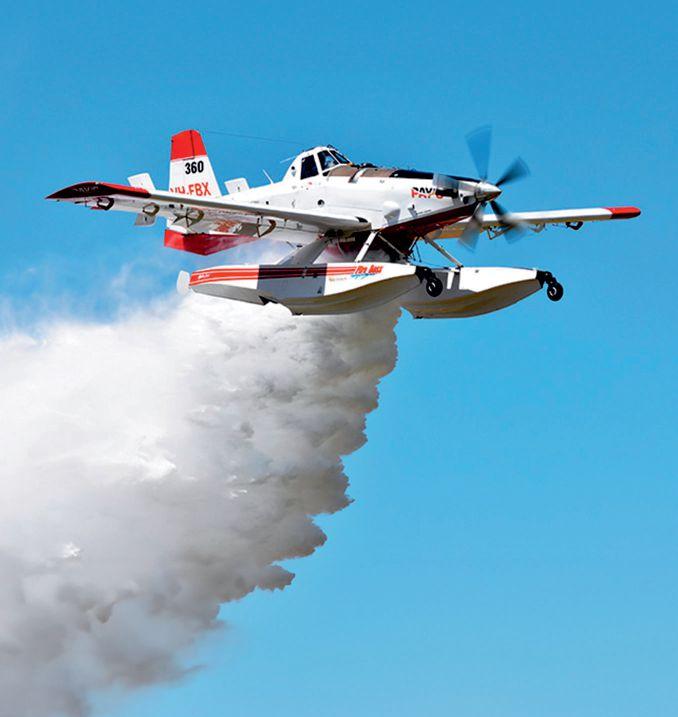
end-to-end system supporting ATU, AFF, text messaging, and more in a single box. Guardian Mobility is launching its new G6 Certus product that will provide higher satellite bandwidth speeds compared to SBD technology, introducing new features to their aerial firefighting customers, such as global HD voice channels, picture transfer, live video streaming, and a data link for third-party applications such as ATAK.
Squamish, BC, iqonboard.com
IQonboard was founded by engineers and pilots aiming to add a new level of safety to the helicopter industry. It developed the IQtag and app as wearable technology to provide a real-time view of crew, cargo, and total payload, accessible through a web browser, including Fatigue Risk Management tools.
Boulder, CO, churchillnavigation.com
Churchill manufactures systems to capture and record video, provide real-time augmented reality mapping, and to archive and index recorded video. Its systems are

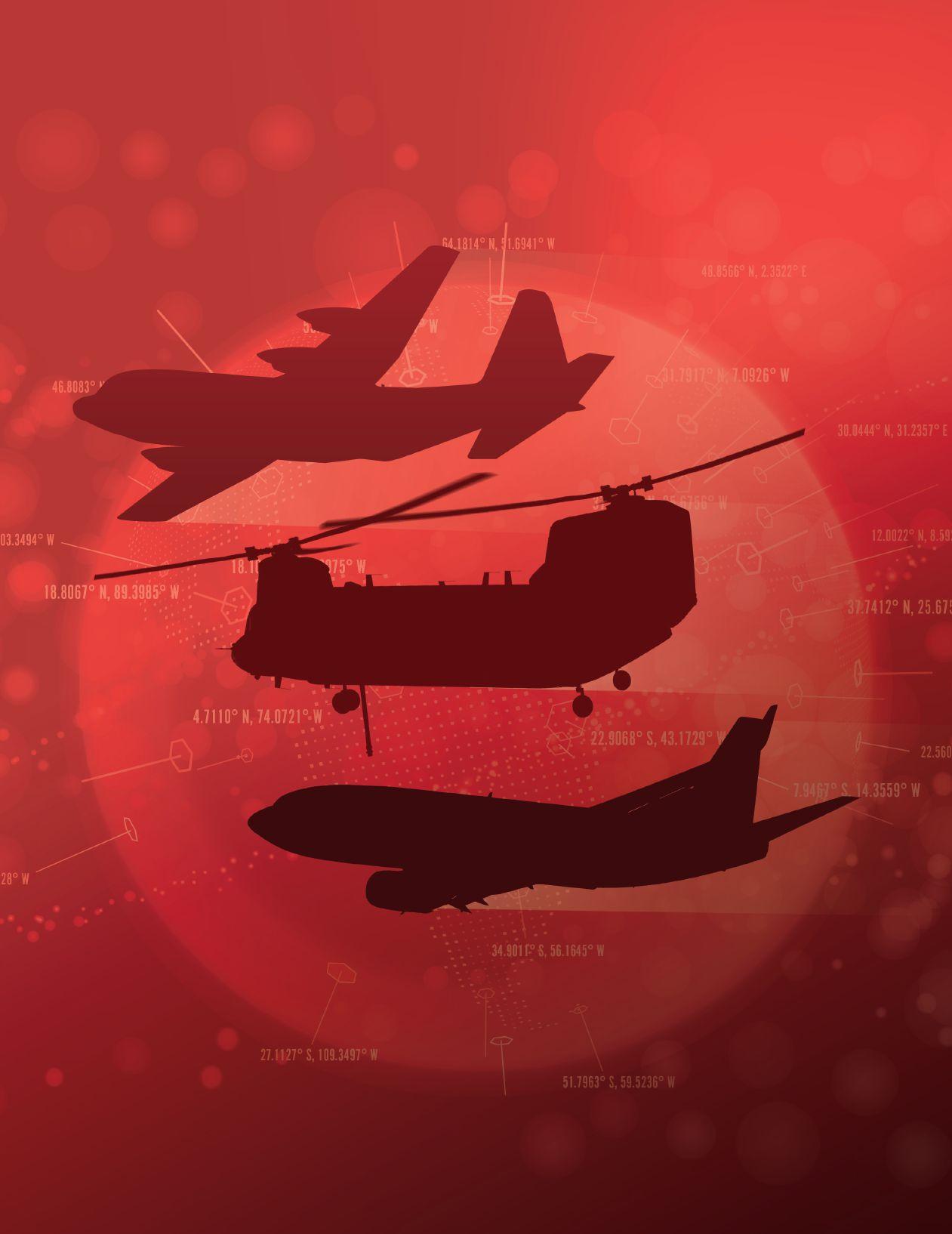
WILDFIRE WARFARE
Our comprehensive fleet of fixed-wing and helicopter resources ensure we can reliably support your needs anywhere in the world, 24/7/365.
by a range of operators in law en-
Toronto, ON, nuvistechnologies.com
Nuvis Technologies has been founded with a vision of improving the quality of life using information and communications (ICT) technologies. The company provides end to end ICT solutions, along with financing if required. Nuvis Technologies in partnership with Amplicam provides an AI-based computer-vision solution to automate the detection and monitoring of forest fires. This includes Realtime monitoring of a more than 1,000 square kilometre area by each camera, with only one dispatcher for 35 cameras.
Hood River, OR, overwatchimaging.com
Overwatch Imaging is a global leader in airborne wildfire intelligence technologies. The venture-backed small business was founded in 2016. It develops AI-driven automation software and multispectral smart sensor payloads that serve a wide range of time-critical missions around the world, from wildfire intelligence and natural
disaster response to counter narcotics, border security, tactical intelligence, and maritime search, rescue and environmental monitoring. Overwatch Imaging systems leverage the latest advancements in computer vison, GPU processing, Artificial Intelligence, and sensor fusion to help automate human-intensive roles of scanning and mapping large geographical areas, searching for small objects of interested, and analyzing constant data streams for actionable intelligence. Wildfire intelligence is a core market segment for Overwatch Imaging, which develops complete, multispectral sensor payloads that collect and process high-resolution image data.
Thunder Bay, ON, air-suite.com
AirSuite’s flagship product, Cirro, is a complete mobile flight operations system built for helicopter and fixed-wing operators to simplify regulatory compliance and flight planning processes. Cirro was created by pilots and operators. It works across iOS and Android devices, in addition to Macs and PCs, and has functionality to be leveraged by varied team members, while
also providing transport auditors with access to the information they need. Cirro is described as the first complete software package of flight management tools to specifically focus on operations. It gives operators access to fleet and crew specific details, with key aspects of flight planning, scheduling, documentation, safety and reporting.
Waterbury, VT, gpms-vt.com
GPMS’s Foresight MX offers a nextgeneration, predictive Health and Usage Monitoring System that goes beyond HUMS. Foresight MX is designed to give equipment operators the power to “Know it before it matters” providing Machine Condition Monitoring, optimized Rotor Track and Balance, and Fleet Data with Exceedance Monitoring in one powerful system. Fully predictive, Foresight MX offers insights needed to optimize maintenance, safety, and operations. GPMS holds STCs for Foresight MX on a range of helicopter platforms.
Denver, CO, RMCI.com
The RMCI Expandable Rotorcraft Diagnostic System or XRDS is a

next-generation HUMS. It is leading-edge technology that helps to ensure a high quality of safety and improved aircraft availability. The use of RMCI’s technology is designed to enhance the ability to accomplish missions with reduced costs and increased safety. The XRDS enables flight data monitoring for Flight Operations Quality Assurance, or FOQA; provides comprehensive mechanical diagnostics of the entire drive train of the aircraft; and supports maintenance functions such as engine vibration checks and rotor track and balance. RMCI’s equipment accurately detects emerging problems well in advance to prevent mission interruption, collateral damage of components, and other possible incidents. The XRDS is lightweight and currently installed on 14 different types of helicopters and fixed-wing aircraft.
Kelowna, BC, skytrac.com
For more than 30 years, SKYTRAC has been leveraged by aerial firefighting operators to provide mission critical capabilities for mission success. With almost 40 years of experience in aviation and more than 800 customers, SKYTRAC is a leading provider of LEO satellite and cellular communication services for all aerospace sectors.
Working with operators, organizations, and OEMs, SKYTRAC enables capabilities such as regulatory required automated flight following (AFF), air tanker information systems (ATIS), operational load monitoring (OLM), telemetry, voice, and text communications, low-latency video streaming, real-time HUMS, and more over Iridium Certus and cellular networks.
Auckland, New Zealand, spidertracks.com
Spidertracks is a globally recognized and trusted provider of intelligent flight data and information for aviators around the world. Its technology is leveraged for mission-critical environments and provides teams with real-time flight tracking, active flight following, and two-way text communication.
Mississauga, ON, til.ca
Founded in 1990, Technisonic focuses on the development of aeronautical band VHF ground equipment and Special Mission Airborne RF and audio communications systems. Its tactical airborne VHF, UHF and multi-band communications systems are used for air ambulance, electronic
Whether for firefighting, law enforcement, search and rescue, or emergency medical services, Airbus stands ready to support communities in Canada and around the world. Our versatile range of helicopters perform a multitude of critical missions, helping to take you further, faster and higher, while keeping the world a safe and beautiful place.
Proudly celebrating four decades of supporting Canadian customers locally in 2024.
news gathering, fire suppression, and law enforcement.
Dunedin, New Zealand, tracplus.com
TracPlus is one of the world’s most versatile and adaptable tracking and communications providers, offering real-time tracking, event reporting, and messaging. TracPlus is unique in that it enables multiple asset types to be tracked and integrated into one cohesive system, meaning contractors can use their own tracking systems but send their data to TracPlus when working alongside others. With more than 1,000 customers in 40-plus countries, TracPlus has more than 7.5 million recorded operational hours.
Delta, BC, airborneengines.com
Established in 1991, Airborne Engines Ltd. (AEL) is a Transport Canada Approved Repair and Overhaul facility, an OEM Approved T53 Engine Service Center and a Rolls-Royce M250 Approved Maintenance Repair, and Overhaul Center (AMROC). The company’s Quality Assurance Program

airbus.com
is designed to exceed industry standards, support superior technical personnel, invest in state-of-the-art equipment, and create a long-term operational history. Airborne Engines holds an extensive in-house reworks capabilities.
Medicine Hat, AB, amtech-group.com
Formed in 1991, Amtech is a multidisciplinary technology and engineering company providing professional services and speciality products in aeronautical/ certification engineering. Amtech has extensive experience working with aircraft certification authorities, including TCCA, FAA, EASA, CAA, and with other international authorities. Amtech is delegated by Transport Canada to approve major modifications on all categories of fixed- and rotor-wing aircraft under Design Approval Organization (DAO) delegation. The company has seven Designates (DEs) on its DAO facilitating support of complex aeronautical design and certification projects. Amtech has extensive experience in the design and certification of modifications and repairs to fixed and rotary wing aircraft. This includes structural modifications and repairs, interior systems modifications, avionics and electrical system modifications,
float installations, special mission aircraft (such as airtankers), flight characteristics assessment (flight test and analysis), ferry tank installations, powerplant conversions, and data acquisition systems.
Mississauga, ON, ateq-aviation.com
ATEQ Canada describes itself as the only in-country OEM to manufacture and supply the full lifecycle of pitot/static testing. This includes test adapters for 450-plus aircraft, air data test boxes, calibration, and repair. Its test adapters use 7075 grade aircraft aluminum, preventing breaks from drops and usage. It also leverages stainless connectors/elbows to prevent rust and corrosion.
Adelaide, Australia, biocentral-labs.com
BLAZETAMER380 is at the forefront of wildfire suppression technology, known for its non-toxic, environmentally progressive fire suppressant. Founded with a mission to enhance the effectiveness of firefighting, BLAZETAMER380 is used globally in direct attack operations from both air and ground. The company has a dedicated branch in the United States, with a specialized team that supports its global

operations and collaborates closely with leading firefighting agencies and aviation fleets.
Abbotsford, BC, cdnairparts.com
Established in 1993 and Canadian owned, Canadian Air Parts has eight employees and worldwide 24/7 Support, including wildfire support across Canada and the United States. The company serves as a distributor for Lord Corp., Concorde Battery, Tech Tools Windows, Spidertracks, RC Allen, Thixo Grease and others. It holds a large inventory supporting all the models for OEMs such as Airbus, Bell and Sikorsky. Canadian Air Parts provides exchange programs for Rotable needs and customer consignments. Its aircraft part outs include S76, AS350, while also offering System X Ceramic.
Winnipeg, MB, canadianpropeller.com Canadian Propeller is North American leading propeller service facility. This includes its standing as a certified Hartzell Propeller Factory Authorized Service Facility, McCauley Authorized Service Facility and MT Propeller Service Center. As a Sensenich Propeller Repair Facility, its

team has the capabilities to MRO major lines of Sensenich propellers and accessories. Canadian Propeller also serves as a Hamilton Sundstrand Sales and Service Center, which includes composite propellers. In addition to its focus in Western and Northern Canada, Canadian Propeller has customers across the rest of the country and into the United States. The company also provides on-wing-maintenance services as needed.
Abbottsford, BC, cascadeaerospace.com
Cascade Aerospace, an operating unit of IMP Aerospace & Defence, supports a diverse range of airframe platforms and operational needs. This includes supporting military, government, and commercial aircraft. Cascade is well-known for its aerospace engineering services for custom product design, manufacturing, and certification.
Langley, BC, kratosdefense.com
Consolidated Turbine Specialists is headquartered in Bristow, Oklahoma, as an independent MRO facility specializing in PT6 Repair and Overhaul. It is certified by
the FAA, EASA, DOT and DBCA to repair and overhaul Pratt & Whitney PT6T and PT6A series engines. Its Canadian facility is certified by Transport Canada and EASA. Consolidated Turbine Specialists offers a full range of PT6 services: Full engine overhaul and repair capabilities, worldwide 24/7 field service, hot section inspection (H.S.I), OTC part sales, fuel nozzle overhaul/exchange, accessory overhaul/repair, component overhaul/repair, reduce engines to spares, AOG support, upgrade modification, and part sales.
Mississauga, ON, hopeaero.com
Hope Aero is Canada’s leading aircraft component maintenance specialist, optimally located to serve Canadian operators best. We focus on propellers, wheels & brakes repair & overhaul, dynamic balancing and NDT. At Hope Aero, “Our Team Cares About Maintaining Flight Safety.” Hope Aero is optimally located to service Canadian aviation through its Toronto area location at CYYZ and Winnipeg location at CYWG.
Kelowna, BC, kfaero.ca
KF Aerospace is Canada’s largest

commercial MRO provider. For 54 years, KF Aerospace’s multi-faceted business operations have grown to include first-class engineering and design services, military aircrew training, commercial aircraft leasing, passenger and air cargo flight operations, with the same commitment to quality established by its founder in 1970.
Cary, NC, lord.com
Parker Lord manages the unique challenges of shock, vibration, and motion control in flight-critical components and systems. A subsidiary of Parker Hannifin Corporation, Parker Lord is a leading manufacturer of advanced adhesives and coatings, as well as vibration and motion control technologies that significantly reduce risk and improve product performance. Parker Lord supports technologies in aerospace, climate control, electromechanical, filtration, fluid and gas handling, hydraulics, pneumatics, process control, sealing and shielding, and human motion.
Winnipeg, MB, propworks.ca
With facilities in Winnipeg and Edmonton and over 30 employees, PropWorks has grown to be the largest propeller overhaul

and repair company in Western Canada. PropWorks has been awarded a multi -ear contract by Babcock Canada to service the propellers on the fleet of firefighting aircraft they operate for the Government of Manitoba. PropWorks has also been awarded a multi-year contract by Avincis to service the propellers on the fleet on eighteen CL415 aircraft that they operate for the Government of Italy. PropWorks has become the leading expert in overhauling and repairing the propellers on the CL415.
Las Vegas, NV, safestructuredesigns.com
Safe Structure Designs (S.A.F.E.) is a global leader in the design, engineering, and manufacturing of ergonomic safety equipment for the aerial firefighting industry. The company’s design process is completely free of cost, and it is focused on providing the best solution for each client’s unique circumstances.
Kelowna, BC, selecthelicopter.com
Select Helicopter Services specializes in the maintenance, repair and overhaul of hydraulic components and cargo hooks. Capabilities include components from Bell 206/206L/212/214/407/412/427/
UH-1, as well as Airbus H125 (AS350) and AS355. Cargo hook capabilities include hooks manufactured by Onboard Systems International, Dart Aerospace (Canam), Mechanical Specialties, Drallim Aerospace (Cargo Aids), Breeze-Eastern and Bell Helicopter. Transport Canada Approved (EASA, AMO, Controlled Goods), the team at Select combines 45-plus years of aircraft maintenance experience across the globe.
Scottsdale, AZ, standardaero.com
StandardAero is one of the world’s largest independent providers of services including engine and airframe maintenance, repair and overhaul, engine component repair, engineering services, and interior completions. StandardAero serves a diverse array of customers in the airline, business and general aviation, military, helicopter, and energy markets.
Scottsdale, Arizona, taeaerospace.com
TAE operates facilities throughout AsiaPacific and the Americas to service a worldwide customer base, providing a range of aerial firefighting products and services for both fixed- and rotary-wing applications. The company specializes in OEM-backed
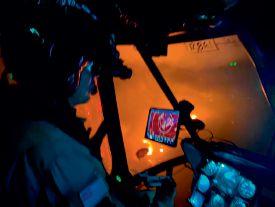
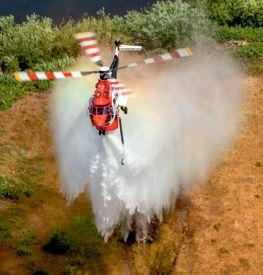

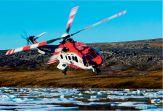


fuel controls, power turbine and overspeed governor and starter generator services.
Englewood, CO, unitedrotorcraft.com
United Rotorcraft is the products division of Air Methods with more than 25 years of experience installing airframe accessories on rotor and fixed-wing aircraft. The company designs, integrates and installs medical equipment, avionics, and accessories for EMS, medevac, firefighting, airborne law enforcement, and SAR operators.
Richmond, BC, westernpropeller.com
Canada’s original propeller MRO is celebrating 75 years of service to the worldwide aviation industry. At its two locations in Richmond, BC, and Calgary, AB, Western Propeller services all major makes and models of propellers and governors including Hamilton Sundstrand, Hartzell, McCauley, MT Propeller & Woodward.
Norway, vestaerotech.com
Founded in 2022 in Norway by a helicopter pilot, Vest Aero Tech focused on developing a new way to fight wildfires. Its aerial tool uses local water sources to provide a

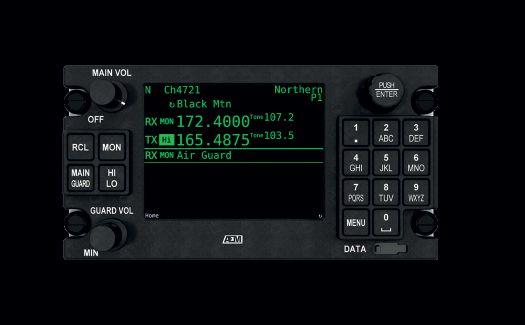
constant water flow, supporting wildfire efforts. It’s also versatile with the ability to help combat floods and more. Building on this innovation, Vest Aero has expanded to create new tools for the future of the VTOL industry in responding to natural disasters.
North Saanic, BC, vihaerospace.com
Led by Original Equipment Manufacturer (OEM) approved Technician Managers, VIH Aerospace provides value-enhanced helicopter maintenance, manufacturing, repair and overhaul (MMRO) services, emphasizing its technical abilities to work on projects that exceed Original Equipment Manufacturer (OEM) specifications. The company provides services for structures, avionics, painting, components, design and STC development. VIH Aerospace is Bell Customer Service Facility and provides services for Sikorksy and Airbus helicopters.
EXECUTIVE FLIGHT CENTRE
Calgary, AB, efcaviation.ca
Executive Flight Centre’s core business has been aviation fuel for more than 40 years. It holds an established network of
infrastructure, dedicated aviation trucks, and long-term relationships with Canada’s primary fuel refiners to ensure a dependable fuel supply of Jet A1 and Avgas (100LL) to customers throughout Western Canada. The company has been a provider of aviation fuel to aerial firefighting operations for over 20 years.
Keswick, Australia, firexit.com.au
FireXit Pty Ltd. was formed in 2009 with the intention of supplying products that promote the well-being of people, animals and the environment. The company distributes Fire Knock Out as a small, lightweight product that works as soon as it comes in contact with flame. FireXit explains the contents of Fire Knock Out are not harmful to people, animals or the environment and can be applied both preventively and actively.
Peterborough, ON, kadexaero.com
KADEX Aero Supply is a leading supplier of aircraft parts and supplies, offering a wide range of overhaul and repair services through its three locations across Canada: Peterborough, Ont., Winnipeg, Man., and Calgary, Atla. Working with maintenance
FireXit is a Canadian Company based in Calgary which distributes a new line of e ective products to the firefighting industry. All of our Unique Products are Non-toxic and Free of all carcinogenic PFAS substances and is designed to reduce firefighter’s exposures to harsh and toxic combustion residues and chemicals used in the firefighters workplace.
InfernoX™ is our Flagship PFAS-Free product, is an AFFF replacement product for Class B fires and is a Superior Wetting Agent on Wildland and Class A fires.
InfernoX™ increases the e ectiveness in both Spreadability and Penetration rates between 200 and 600% based on dilution rates.
FireXit “Surface Cleaner" is a Safe and Highly e ective DECON site product for equipment and hard surface cleaning and decontamination.
FireXit “Personal Decon Wipes" o er self-decontamination cloths for frontline wildland firefighters to remove fire residues from skin.
www.FireXit.ca
organizations and operators for 30 years, KADEX provides all the necessary components to maintain aircraft, including engine oil, batteries, tires, spark plugs, filters, exterior and interior lighting, brake components, instruments, and more. A Canadian family-owned and operated business, KADEX has been serving worldwide maintenance organizations with industryleading service since 1994.
Saskatoon, SK, mklgroup.com
MMKL Group specializes in providing distribution channels for emergency management supply chains, focusing on wildfire suppression equipment and solutions. Established to meet the critical needs of wildfire response teams, MMKL Group supplies a comprehensive range of fireline hand tools such as Pulaskis, McLeods, shovels, axes, and rakes, essential for creating firebreaks and controlling ground fires. MMKL Group ensures firefighter safety with a line of wildland fire helmets, Nomex clothing for flame resistance, and durable wildland boots designed for heat protection and terrain support. With our supply comes new early fire detection solutions to help firefighters fight fires as safely and efficiently as possible.
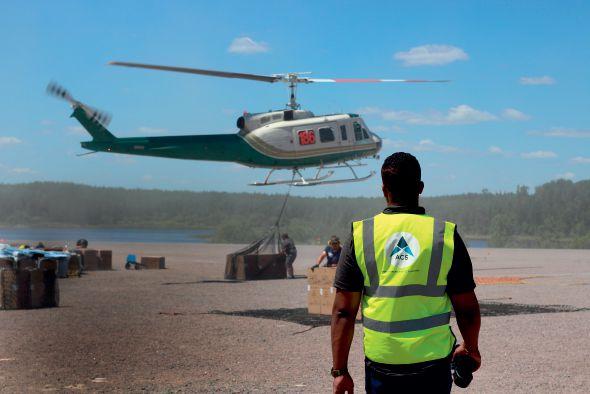
Response
knowledge, global presence, available 24/7
of Aircraft
to over 50,000
Mississauga, ON, pearcanada.com
With a distribution centre in Richmond, BC, PEAR Canada provides a range of aviation fuel handling needs, which includes filtration, fuel sampling/testing, aviation hose, filtration, single-point and over-wing fueling nozzles, pressure/delta P gauges, hose reels, bonding reels, pumps, meters, filters, and pipe fittings/valves, fueling cabinets, and related products.
Langley, BC, petrovalue.ca
PetroValue is one of Canada’s leading independent distributors of aviation fuels, diesels, gasolines, and lubricants. Since its inception in 1999, PetroValue has developed an extensive supply network to offer customers petroleum products across Canada. The company emphasizes its logistics background and experience with building unique distribution platforms.
Kelowna, BC, tempest.aero
Tempest has been providing global helicopter parts support since 2001. Our team consists of highly experienced and deeply passionate experts. Tempest is dedicated to keeping its clients flying, by holding a large
inventory of serviceable parts. ITs inventory is continuously evolving to include a wide variety of aircraft model types.
Chantilly, Virginia, amentumcareers.com
Amentum is a global firm in designing, engineering, managing and modernizing critical systems and programs of national significance across defense, security, intelligence, energy, and environment. It is American government and commercial services contractor based in Chantilly, Virginia, that was formed in 2020 out of the federal business of AECOM. The company has more than 35,000 employees, including an emphasis on hiring military veterans, in 79 countries on all seven continents.
London, ON, aircharterservice.com
Founded in London in 1990, Air Charter Service (ACS) is an award-winning charter specialist, arranging more than 28,000 charter flights per year and with revenues exceeding $1 billion in each of the past four years. The company has a global network, with 35 offices worldwide, spanning all six
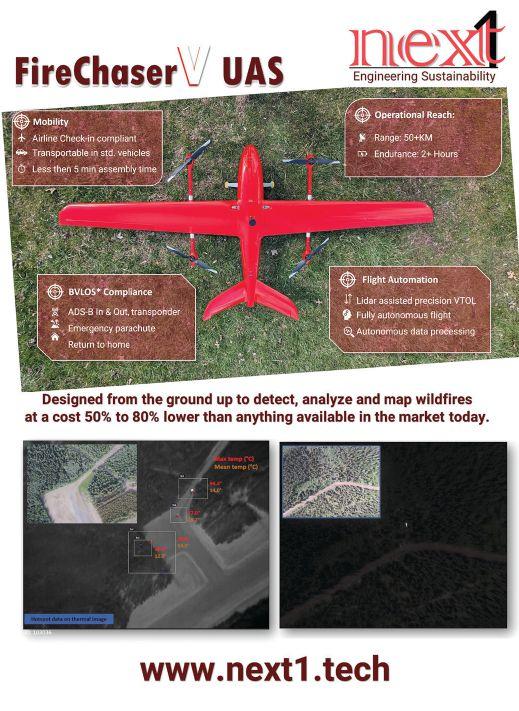
major continents. ACS has a proud history of supporting governments and NGOs in times of crisis, both in urgent evacuations and helping to get aid to where it is needed.
Montreal, QC, cae.com
CAE digitalizes the physical world, deploying software-based simulation, training and operational support solutions to help enable aviation professionals and defence and security forces to perform. CAE has approximately 13,000 employees in more than 240 sites and training locations in over 40 countries. Domestically, CAE’s public safety and security portfolio now extends into technologies for keeping Canadians safe from natural disasters, including the CAE SkyDeploy real-time position reporting system for wildfire tracking, search and rescue management, and fisheries surveillance.
Toronto, ON, element-aerospace.com
Element Aerospace is a boutique aviation consulting firm that specializes in business aviation, powerplant and aircraft asset management, aircraft and spare parts sales and acquisitions, OEM representation, infrastructure development, special

mission aircraft, and other unique projects. Based at First Canadian Place in Toronto, Ontario, Element Aerospace is composed of a team of managing partners that have in-depth industry knowledge with an international footprint.
Ann Arbor, MI
In operation for more than 50 years, FAAC is a training solutions provider with a focus on developing tools for simulation training across a range of sectors, including military, public safety and commercial applications. FAAC Commercial provides simulation training for public safety and transit, designed to meet standard practices for police, fire, ems, bus, and rail professionals. FAAC Commercial provides tools and training techniques designed for maximum learning retention in safe, controllable, and repeatable training environments.
Washington, DC, metrea.aero
Metrea is a provider of effects-as-a-service to national security partners across multiple domains and over a dozen mission areas. In the company’s defined Air & Space sector, it provides full-stack, ready-to-deploy, agile capabilities in critical air domain
mission sets. This includes Airborne ISR and Special Mission Aviation, Air-to-Air Refueling, Advanced Tactical Rotary Wing Training and Executive Aviation.
Calgary, AB, skyplan.com
Skyplan is a global provider of comprehensive flight-operation and trip-support services. With the launch of the latest iteration of its flight-planning software, Aurora, a flight department has immediate access to web-based global flight planning, weather services, up-link, Air Traffic Control (ATC) filings, and integrated runway analysis. Users can leverage the company’s TripSupport and Fixed Based Operations team to access Skyplan’s global service network for contract fuel, overflight and landing clearances, ground handling, concierge services, custom arrangement facilities, and private jet charters.
Campbell River, BC, 49northhelicopters.com
Founded in 2005 as a flight school under the name Coast Mountain, 49 North
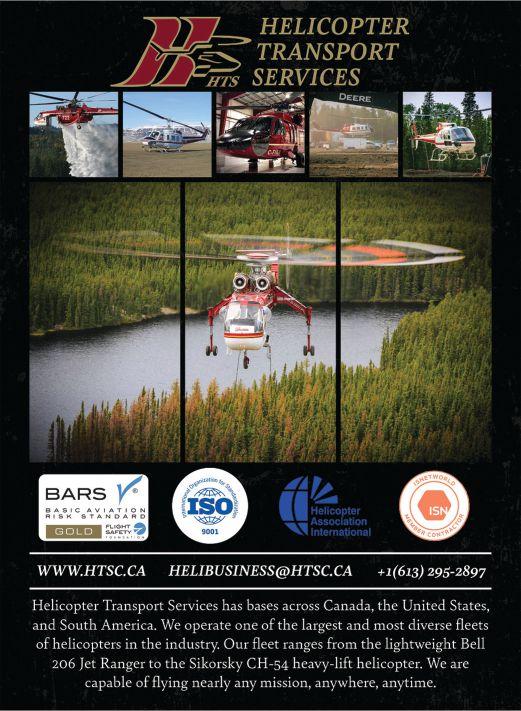
Helicopters has a team of experienced pilots specializing in light and medium helicopters across western Canada. Their services encompass a diverse range of operations, including fire suppression, longlining, forestry, bird towing, surveying, and patrols.
Prince George, BC, aberdeenheli.com
Aberdeen Helicopters is a versatile multimission provider situated in Prince George, BC. Its services encompass fire suppression, forestry applications, mountain climbing support, back-country hiking assistance, skiing excursions, fishing trips, wilderness photography flights, mining exploration, and powerline maintenance.
Vernon, BC, advantageheli.com
Founded in 1994, Advantage Helicopters is an owner-operator driven company holding Bell aircraft that are fire-suppression ready. The company primarily offers helicopter charter services and also holds aircraft maintenance organization status.
Nordegg, AB, helinordegg.com
Founded in 1997, Ahlstrom Air specializes

in commercial helicopter services with an emphasis on forestry, including fire suppression, fish and wildlife surveys, and animal tracking. The company is involved in seismic, oil and gas, and provides support for remote access and SAR missions.
Sechelt, BC, airspanhelicopters.com
As a Transport Canada-approved maintenance facility, Airspan Helicopters maintains a fleet of six helicopters and offers a range of services, focusing on forestry work and including aerial firefighting support.
Kelowna, BC, alpinehelicopters.com
Operating since 1961, Alpine Helicopters provides aerial firefighting and related services. The company offers various other services such as heli-skiing, heli-hiking, mountain rescue, seismic and mining support. With a fleet of 40 helicopters, including Bell 212HP BLR, Bell 407, Bell 206L1/3, and AS350B3e types, Alpine Helicopters has additional bases in Golden, BC as well as Calgary, Canmore, High Level, and Grimshaw, Alberta.
ARROW HELICOPTERS
Revelstoke, BC, arrowhelicopters.com
Established in 2005, Arrow Helicopters
specializes in providing Vertical Reference Training for both high- and low-time pilots. The Class D approved company is known for Search and Rescue (SAR) services, fire suppression, as well as mountain missions like avalanche control.
Parksville, BC, ascenthelicopters.ca
Ascent Helicopters, a Class D approved operator, offers fire suppression and serves various sectors including utilities, construction, film and television, heli-skiing, air ambulance, and natural resources. Ascent holds a second base in Fernie and a fleet of approximately eight helicopters.
Vernon, BC, auroraheli.com
Aurora Helicopters specializes in fire suppression and pre-suppression services. These services include transporting firefighting personnel and equipment to predetermined locations, conducting aerial smoke patrols to detect forest fires in high hazard areas, and engaging in suppression activities like water bucket drops.
Ottawa, ON, Babcockcanada.com
Babcock Canada provides critical services, technology, and support solutions in

defense, emergency services, and civil nuclear domains. With over 30 years of aerial firefighting experience, Babcock operates a substantial fleet of more than 90 owned aircraft, conducting over 5,000 firefighting missions annually and accumulating more than 15,000 firefighting flight hours.
Fort St. John, BC, baileyhelicopters.com
Founded in 1989, Bailey Helicopters offers diverse services across multiple industries. Bailey is a company of 70 personnel with bases in Fort St. John, Fort Nelson, Prince George, Terrace (BC), along with satellite bases in Edmonton, and Calgary (AB). Bailey Helicopters has 18 Helicopters in its fleet including Bell 212’s, AS350 B3, B2, BA and Bell 206’s. Bailey offers passenger transport, aerial ignition, water bucketing and stand by medivac during wildfire season.
Cranbrook, BC, bighorn.ca
Bighorn Helicopters, founded over 30 years ago, offers a range of services including fire suppression. It's authorized to operate helicopters for provinces including Alberta, BC, Saskatchewan, Manitoba, and Ontario. The company is certified for aerial work and aircraft maintenance.


BLACKCOMB HELICOPTERS
Whistler, BC, blackcombhelicopters.com
With over 30 years of experience, Blackcomb Helicopters assists in firefighting, human transport, water bucketing, Bird Dog flights, equipment transportation, and more. The company emphasizes multi-mission helicopters, focusing on rescue, medevac, and operating a wide variety of 25 intermediate and medium helicopters.
Berwyn, AB, blackswanhelicopters.com
Founded in 2003, Black Swan Helicopters specializes in forestry services such as surveying, longlining, and fire suppression. The company offers charter and maintenance services for Airbus, Bell, and Robinson helicopters.
Brackendale, BC, blacktuskhelicopter.com
Black Tusk Helicopters provides fire suppression and other services for various agencies across provinces. Equipped with Bambi Buckets and automated flight systems, its fleet supports firefighting efforts in BC and Alberta with specialized features like foam-injection systems.
Les Cedres, QC, canadianhelicopters.com
With roots tracing back to 1947, Canadian Helicopters specializes in personnel and cargo transport, fire suppression, seismic surveys, and more. With flight training and maintenance operations, the company operates in eight Canadian provinces and territories.

Kelowna, BC, coldstreamhelicopters.com
Coldstream Helicopters specializes in emergency services such as fire suppression, mountain rescue, disaster support, evacuation services and longlining, as well as powerline construction and construction work. With bases in British Columbia, Alberta and Manitoba the company is equipped for various helicopter operations and missions.
Abbotsford, BC, conair.ca
Conair is a global leader in aerial firefighting, offering the largest privately-owned fixed-wing fleet of specialty aircraft in the world. Operating across Canada, the US, Europe, Australia, and beyond, the organization provides a comprehensive range of aircraft, crew, maintenance, and training to support government agencies fighting wildfires. With a strong focus on safety,

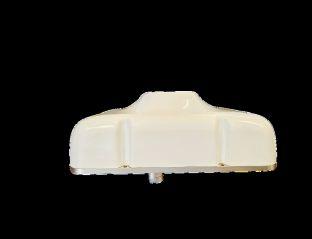

Conair offers pilots access to a Training + Tactics Centre, which includes specialized aerial firefighting simulators designed to enhance successful missions in real-world operations. Conair boasts a versatile fleet of 70 aircraft, including Bird Dogs, Land-Based Airtankers, and Amphibious Aircraft, such as the CL415 and AT802 Fire Boss. The latest addition to Conair's fleet is the Dash 8-400 airtanker.
Fort Langley, BC, contourhelicopters.com
Founded in 2019, Contour currently operates a fleet of four AS350 B3s, one Bell 206B3, one Bell 206L3 and one UH60A+ Blackhawk in wildfire suppression roles. Its second UH60 is currently in completion and expected to be ready for the 2025 wildfire season. Contour is approved for NVG operations and is working to develop a NVG wildfire program with B.C. and Alberta agencies. The helicopter operation also has base locations in Burns Lake, B.C. and Edmonton.
Port Alberni, BC, coulsonaviation.com
For more than 60 years, Coulson Aviation has protected the world from forest fires. The company provides aerial support
across continents with a diverse fleet of day and night assets, and is the only aerial firefighting company operating both fixed- and rotary-wing aircraft. Its approach includes designing, maintaining, and operating various aircraft, supported by comprehensive training programs. Coulson Aviation is the first aviation company to receive Transport Canada Approved Training Organization (ATO) approval for aircraft structures training. Its program allows students to earn their Aircraft Maintenance Engineer – Structures (AME-S) license at no cost, with guaranteed full-time positions upon completion. As a leading supplier to governments worldwide, Coulson focuses on sustainable, in-production aircraft. Partnering with OEMs and utilizing the latest technology, the company delivers allhazard response capabilities.
St. Andrews, MB, customheli.com
Founded more than 45 years ago, Custom Helicopters operates a versatile fleet of over 35 helicopters, ranging from light to heavy models. These helicopters support a range of industries, including powerline maintenance and construction, mining exploration, 24/7 medevac services and fire suppression. The company’s fleet includes



Airbus AS332L2 and Bell 205 helicopters, which are utilized for fire suppression activities in both Canada and South America. With 10 established bases across Canada, Custom Helicopters is always prepared to assist in firefighting efforts.
Appleton, Minnesota, dauntlessair.com
Dauntless Air is a leading U.S. operator of the AT-802F Fire Boss, a water-scooping air tanker purpose-built for cost-effective aerial firefighting. The company owns and operates 17 Fire Bosses, which feature some of the latest in firefighting technology, including on-board gel-mixing to enhance drop effectiveness, infrared/HUD capabilities to ensure drop accuracy, and ADSB and HASAS warning systems as well as proactive engine management to improve safety.
Sturgeon County, AB, deltahelicopters.com
Delta Helicopters, in addition to its Edmonton head office, operates from five other base locations. With over 45 years of experience working with the forestry industry across Canada, Delta provides comprehensive fire suppression support.
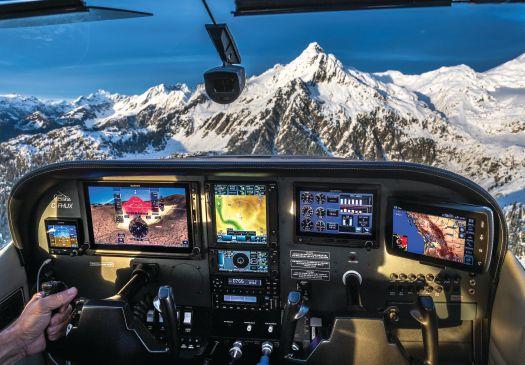

DISCOVERY HELICOPTERS
Atlin, BC, discoveryheli.ca
Founded in 1990 as a family-owned company, Discovery's helicopters are equipped for fire suppression, featuring satellitebased flight following systems, satellite phones, Bambi buckets, and longlines.
Salmon Arm, BC, eastwesthelicopters.com
Established in 1997 with a focus on logging operations, East West Helicopters holds extensive experience in longline operations and aerial firefighting. The company specializes in precision lift work and operates a self-contained service facility, including its own tanker for helicopter refueling.
ECLIPSE HELICOPTERS
Penticton, BC, eclipseheli.com
With bases in Penticton and Cranbrook, BC, Eclipse provides a range of services including aerial firefighting, as well as SAR and U.S.-based operating experience.
EDMONTON REGIONAL HELICOPTERS
Edmonton, AB, erhelicopters.com
As a privately held operator, Edmonton Regional is based at Edmonton International
Airport (CYEG) with offices at Executive Flight Centre Terminal 1. The company provides forestry services throughout central Alberta, extending west to the Rocky Mountains.
Kenora, ON, foresthelicopters.com
Established in 1997 and focusing on AS350 helicopters, Forest Helicopters supports all aspects of fire suppression. The company's pilots possess extensive experience beyond baseline requirements, including in-depth knowledge of fire behavior, logistical support, and tactical applications such as aerial ignition.
Williams Lake, BC, frontlinehelicopters.ca Frontline Helicopters, situated just south of Williams Lake, is a key provider of wildfire suppression and associated services, including air taxi, infrared scanning, mapping, wildlife capture, and surveying.
Yellowknife, NWT, gsheli.com
Metrea_CWC.AD_Print_202408.pdf 1 15/08/2024 09:33
Great Slave Helicopters operates a diverse fleet of over 30 single- and twin-engine helicopters, with over 20 percent being aboriginally owned through partnerships
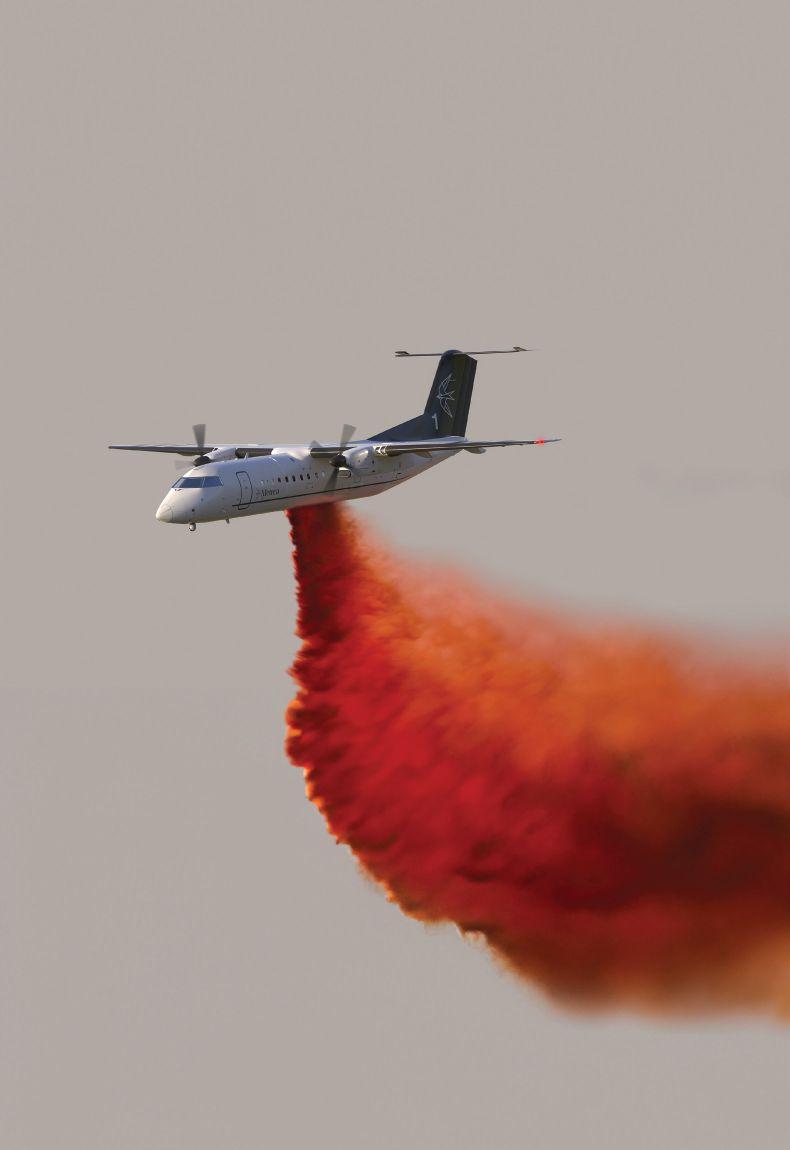
with various operators. Operating across Northern Canada, this group manages around 15 bases, offering forestry services, including wildfire suppression.
Campbell River, BC, grizzlyhelicopters.com
Established in 2008 as a family-owned and operated business, Grizzly Helicopters employs ASTAR350 B2 helicopters from bases in Campbell River and Port McNeill. The company specializes in providing firefighting services in the region, along with applications like, medevac, powerline patrols, and wildlife management.
Calgary, AB, guardianhelicopters.com
Founded in 1995, Guardian Helicopters has its head office at the Springbank Airport in Calgary, Alberta. Apart from its oil and gas work, Guardian delivers an array of services such as aerial ignition, infrared scanning, cone collection, GPS, and video mapping.
Ottawa, ON, htsc.ca
Founded by Luc Pilon in 1976, Helicopter Transport Services (HTSC) has grown from
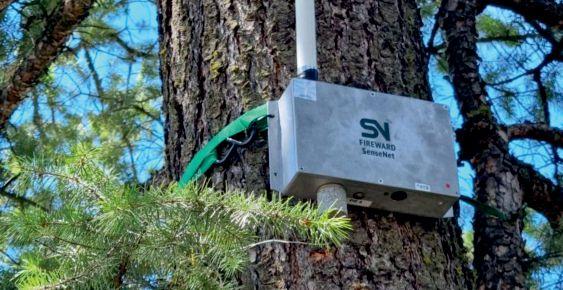
a single-aircraft operation based in North Bay, Ont., to one of North America's largest privately held helicopter operators. With more than 48 years of experience, HTSC operates a diverse fleet of more than 60 helicopters and one fixed-wing aircraft, serving clients across various sectors including mining, forestry, wildfire support, utility, construction, national defense, and emergency medical services. HTSC's permanent pilot staff averages more than 7,000 hours of helicopter flying experience, underscoring its commitment to safety and operational excellence. HTSC’s operations span across Canada, the United States and South America.
Red Deer, AB, helisourceltd.com
Heli Source is a comprehensive provider of forestry sector services, encompassing fire suppression, aerial seeding and fertilizing, logging support, heli-torching, and more. The company specializes in mountain flying, vertical reference (longline) operations, and is equipped for water delivery and crew transport.
Sturgeon County, AB, heliqwest.com
Operating from its Edmonton-area location and international headquarters in
Colorado, HeliQwest is a charter company specializing in external load operations such as fire suppression, as well as seismic, aerial harvesting, inspection, surveillance, mapping, photography, survey, and general transport. The company also has a second base near Duncan, BC.
Nelson, BC, highterrainhelicopters.com
Serving the Kootenays since 1992, High Terrain operates Bell and Airbus helicopters out of Nelson, Nakusp, and Kaslo, adhering to aerial firefighting guidelines set by CIFFC and HAC. The company's capabilities include longline slinging, water bucketing, bird dogging, and crew transport.
Whitehorse, YT, horizonhelicopters.ca
Based at Whitehorse Airport with a satellite base in Dawson City, Horizon Helicopters has provided wildfire support in Alberta, BC, and the Yukon since its founding. The fleet primarily comprises AS350 helicopters.
Coleman, BC, hyridge.ca
Hy-Ridge, based in Coleman and
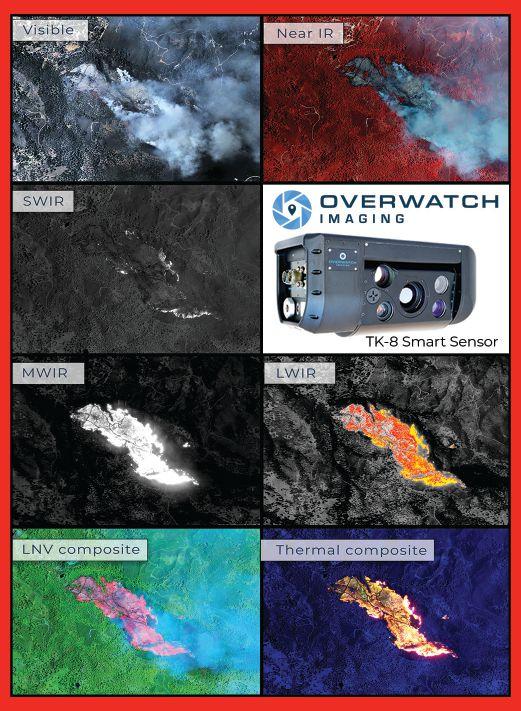
Sparwood, BC, specializes in mountainfocused services, including fire suppression. The company employs an AS 350 B3 helicopter for operations throughout Western Canada.
MAG AEROSPACE CANADA
Dryden, ON, magaero.ca
Founded in 1950, MAG offers fixed-wing and RPAS aircraft for fire surveillance (detection and mapping) and airspace management services. The company provides a spectrum of aerial fire services, including pilots and mission systems operators, maintenance, logistics, and site management.
Vernon, BC, monasheehelicopters.com
With a new base in High Level, AB, to enhance northern service, Monashee Helicopters offers firefighting, construction, film and movie work, as well as passenger transport services.
Blackfalds, AB, mustanghelicopters.com
Established in 2001, with a fleet of 30 helicopters including intermediates, mediums, twin engine Cat A & Class 1 capabilities, Mustang is one of the leading helicopter


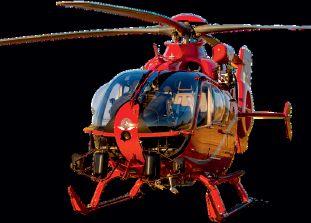


service providers in Canada. Mustang prides itself on being able to support all forestry fire suppression initiatives, including initial attack, transporting field crews, water bucketing, belly tank, running an aerial ignition device or moving precious cargo such as seedlings or suppression equipment. Mustang’s clients include provincial and federal governments, provincial park agencies as well as the private sector. Mustang has base locations across Canada.
Alma, QC, helicopterespanorama.com
Founded in 2000, Panorama Helicopters specializes in a variety of aerial firefighting services. These include fire detection, logistics such as personnel and equipment transportation, bucket watering (Bambi), IR imaging, and related services like medevac.
PHOENIX HELI-FLIGHT
Fort McMurray, AB, phoenixheliflight.com
Phoenix Heli-Flight provides a range of light and intermediate helicopter firefighting services. Its offerings encompass initial attack, sustained action, and helitorching on fires of all sizes.
PRAIRIE HELICOPTERS
Gimli, MB, prairiehelicopters.com
In addition to flight training, Prairie Helicopters delivers a full spectrum of helicopter charter services, including fire suppression. The company, founded in 2000, operates Bell helicopters.
Drayton Valley, AB, rangeheli.ca Range Helicopters specializes in fire suppression services. These include crew and camp moves, infrared scanning, water bucketing, GPS mapping, and drip torching.
Blue Ridge, AB, ridgerotors.com Ridge Rotors primarily serves Northern British Columbia and Alberta's forestry sectors. Their services encompass timber cruising, VRI surveys, mountain pine beetle surveying and extermination projects, fire suppression, emergency evacuation, and Search and Rescue (SAR) operations. The company holds additional bases in Whitecourt, AB, Tumbler Ridge, BC, and Chetwynd, BC.
SARVAIR AVIATION
100 Mile House, BC, sarvair.com
Sarvair Aviation operates from Williams Lake, BC, and 100 Mile House. The


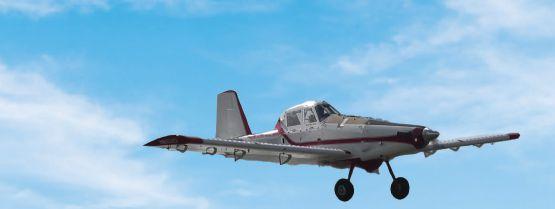

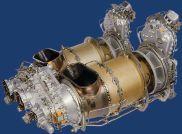


company specializes in longline and vertical lift missions, including heli-logging, drill moves, tower and cone construction, fire protection.
SELKIRK MOUNTAIN HELICOPTERS
Revelstoke, BC, smheli.com
Founded in 1991, Selkirk Mountain Helicopters provides aviation services to heli-skiing operations, SAR support, avalanche snow safety, and firefighting across the region. They hold expertise in various aspects, including drip torch and Class D certification.
SEQUOIA HELICOPTERS
Abbotsford, BC, sequoiahelicopters.com
Founded in 2004, Sequoia Helicopters collaborates with provincial forestry agencies across Canada to aid in fire suppression. The company utilizes Bambi Buckets with foam kits and possesses extensive longline experience. Sequoia Helicopters holds additional Alberta bases in Slave Lake, Lac La Biche and Whitecourt.
SIERRA HELICOPTERS
Pitt Meadows, BC, sierrahelicopters.com
Sierra provides a range of services throughout Vancouver’s lower mainland and beyond, including fire suppression and other
forestry missions like LiDAR imaging, logging, tree planting and wildlife surveying.
SILVER KING HELICOPTERS
Smithers, BC, silverkingheli.com
Silver King Helicopters offers a range of services to the forestry and mining sectors. Their expertise includes fire suppression through collaboration with initial attack crews and water bucketing.
SKY HELICOPTERS
Pitt Meadows, BC, skyhelicopters.ca
Established in 2011, SKY Helicopters boasts a fleet of six helicopters. The company holds relationships with provincial governments to assist in wildfire management and forestry work. its offerings include year-round wildfire suppression pilots and thermal imaging services for detecting hot spots.
Kelowna, BC, skylinehelicopters.ca
Founded in 1996, Skyline Helicopters operates from a main base in Kelowna and a satellite base in Terrace, BC. Skyline Helicopters specializes in longline mountain operations and holds a strong operational focus on oil and gas, forestry, and heli-skiing.

Slave Lake, AB, slheli.com
With roots dating back to 1998, Slave Lake Helicopters specializes in providing services to the forestry sector. This includes fire suppression and related services like LiDAR and infrared scanning, along with crew transport.
Cold Lake, AB, starhelicopters.com
Star Helicopters has been involved with the forestry industry since 1982, carrying out operations including crew transportation, longline bucketing and drip torch services.
Kamloops, BC, summithelicopters.ca
Summit Helicopters delivers remote helicopter aviation solutions in Western and Northern Canada with bases in BC, Alberta, and Northwest Territories.
Qualicum Beach, BC, sunwesthelicopters.com
Founded more than 27 years ago, SunWest Helicopters, based on Vancouver Island, offers a range of services using its fleet of light, intermediate and medium Bell helicopters.
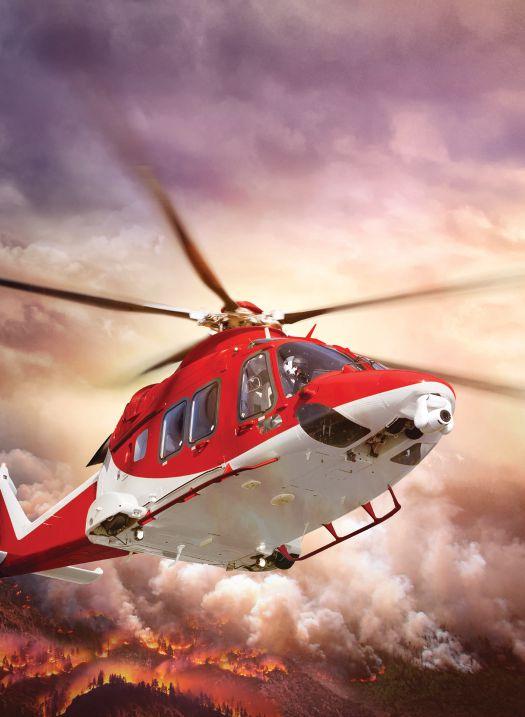
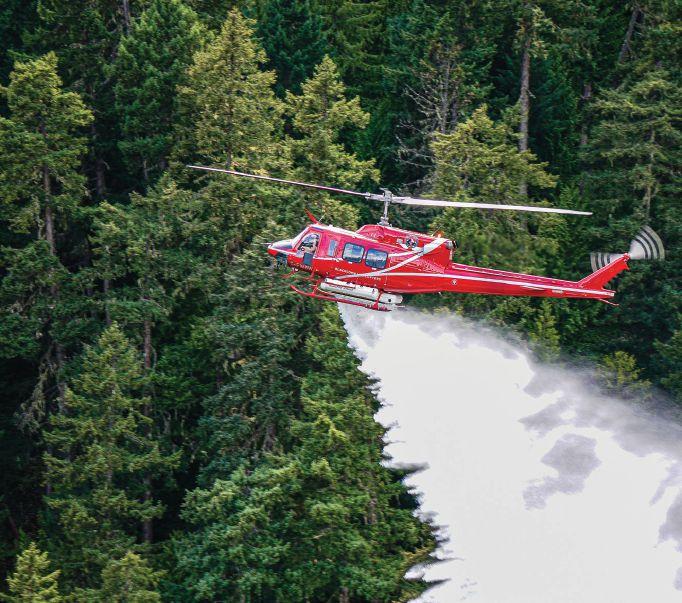
Proudly serving Canada for over 35 years


• AS350 B2 & B3e
• Bell 212 HP BLR
• Fuelling Support

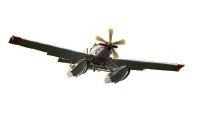
For over 50 years Conair has partnered with governments on forest fire missions around the globe, operating the largest, privately owned, fixed-wing fleet in the world.
A New Generation: Dash 8-400AT | Fast, fuel efficient and tactically flexible. A modern airtanker with a 10,000 litre capacity to drop retardant, water or gel over diverse geography. Setting the standard for NextGen aircraft with OEM support to keep the firefighter flying for decades.
Winnipeg, MB, taigaheli.com
Founded in 1992, Taiga specializes in providing strategic thermal scanning for fire suppression, environmental and biometric analysis, powerline and pipeline integrity, and infrastructure management and maintenance. Their services include detecting and mapping hot spots, hotlines, and risk areas for resource deployment crewed by highly experienced and accredited technicians. The company holds a 30 year plus history of safety in operations.
Oliver, BC, transwesthelicopters.com
Established in 1965, Transwest currently operates a fully-equipped Bell412EP based out of Oliver Municipal Airport. Transwest primarily operates within Western Canada, but we have the capability and extensive experience of working throughout Canada and overseas. In addition to specializing in forest firefighting and utility missions, Transwest provides MRO, part sales and
fire suppression. The company utilizes SEI water buckets that are Aqualaunch/Powerfill foam equipped. Valhalla explains its retardant delivery system can be used for a variety of fire applications.
Hope, BC, valleyhelicopters.ca
Founded in 1985 and relying on a fleet of 9 Bell Helicopters consisting of 206B, 206L4, 407 and 429 types, Valley Helicopters has been providing firefighting services for over 35 years. Its pilots are trained in fire suppression techniques, including water bucketing, aerial ignition, and crew transport. Bases are located in Hope, Merritt and Kamloops, BC.
Victoria, BC, vih.com
VIH Helicopters has been providing global aviation services since 1955. With our excellent track record for safety, efficiency and effectiveness and team of over 300 professionals, we are sure to be able to
Port McNeill, BC, westcoasthelicopters.com
West Coast Helicopters operates as a light and intermediate service provider. They have bases in Nanaimo, Campbell River, Port McNeill, and Bella Coola, along with a fleet of around 18 helicopters. The company provides forestry services such as fire suppression, tree planting, and faller support.
Kelowna, BC, wildcathelicopters.com
Wildcat Helicopters maintains a fleet of Bell 412 and 212 mission-modified aircraft. They specialize in a range of emergency services, including fire suppression. They possess a Bell 412EP configured for extended search, rescue, and medical missions.
Bluff Lake, BC, whitesaddleair.com
As a family-operated company with over 48 years of experience, White Saddle Air Services focuses on fire suppression. They underlined this commitment by acquiring Canada's first commercial Bell 407 GXi in 2019 and have since acquired a second Bell


Yellowhead Helicopters is preparing to celebrate its 50-year anniversary in 2025. With a fleet of more than 40 helicopters with specialized equipment and expert crews strategically located in high-demand areas, Yellowhead Helicopters offers a range of fire suppression and forest restoration services. With 12 bases located in British Columbia and Alberta, Yellowhead Helicopters holds a fleet of AS350 B2s and B3s, Bell 212s and Bell 206s, and BK117s (the five most recently added models). Its helicopters are equipped with firefighting capabilities such as water buckets and long-line equipment. It offers a range of environmental restoration services includes aerial seeding and fertilizing, tree planting, cone harvesting, drip torching, infrared scanning, GPS mapping, telemetry, crew and camp moves, heli-logging. With its recent addition of five twin-engine helicopters, Yellowhead provides Class D fixed-line insertion and extraction, adding levels of safety while augmenting efficiency.
Blenheim, ON, zimmerair.com
Established in 1975, Zimmer Air has focused on serving the forestry sector since its inception. They provide various services in Ontario and beyond, including drip torch and slash pile burning services. | W
Mission
Notre
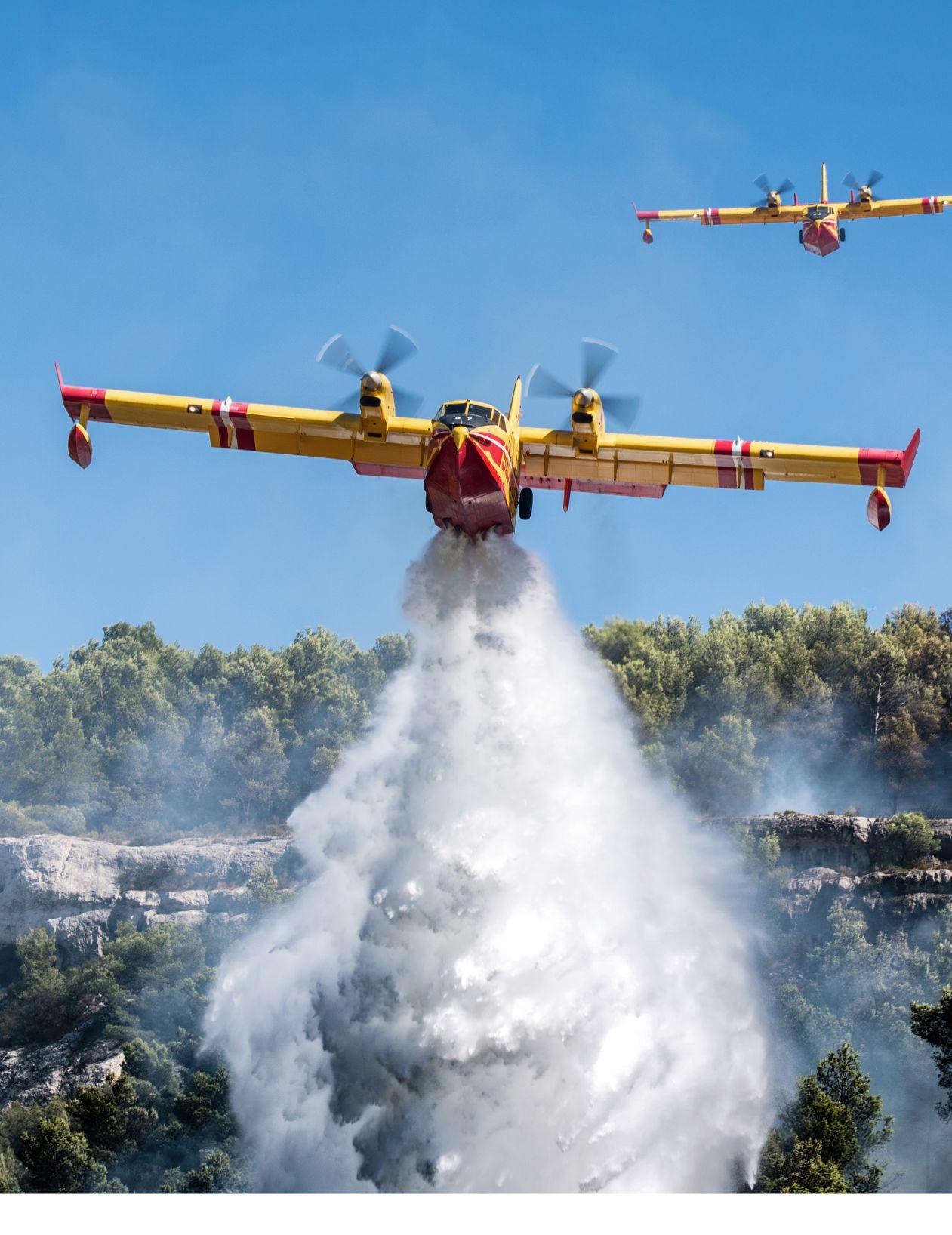
Vision

Notre






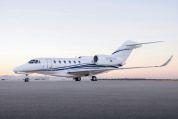


Over 108 acres with lighted runway, hangars and residence.
Established for over 50 years, Just outside Orangeville. Dream lifestyle property with many many features.
Great highway access. Huge potential. $4.6m Let’s chat. Contact Dave 416-578-1303 Fishayr@gmail.com
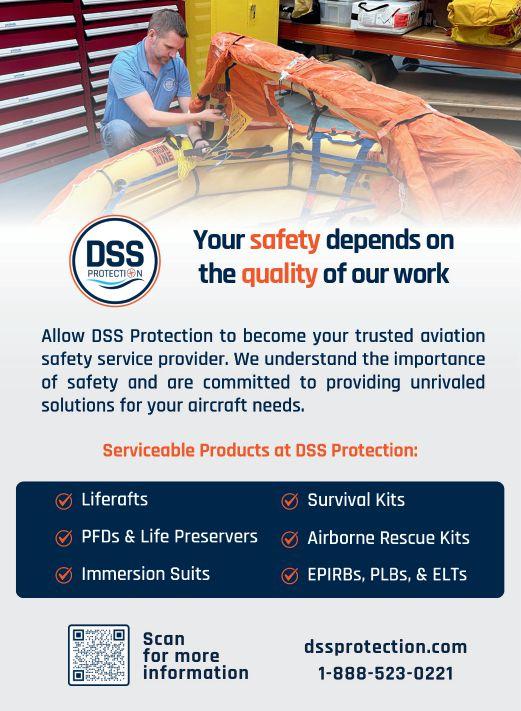
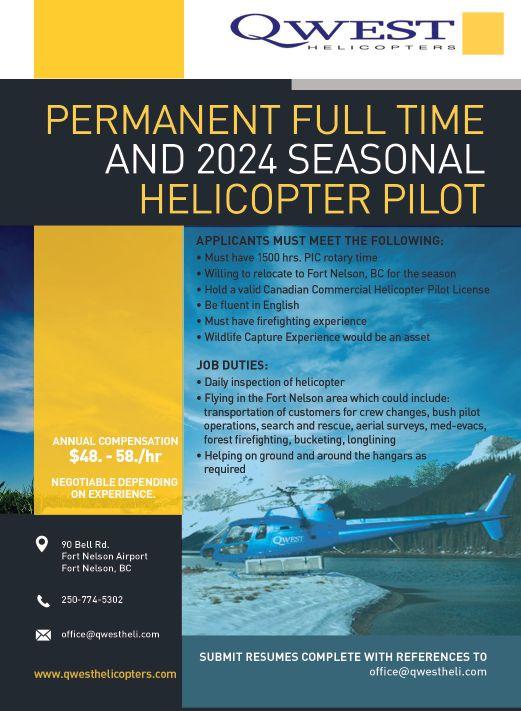



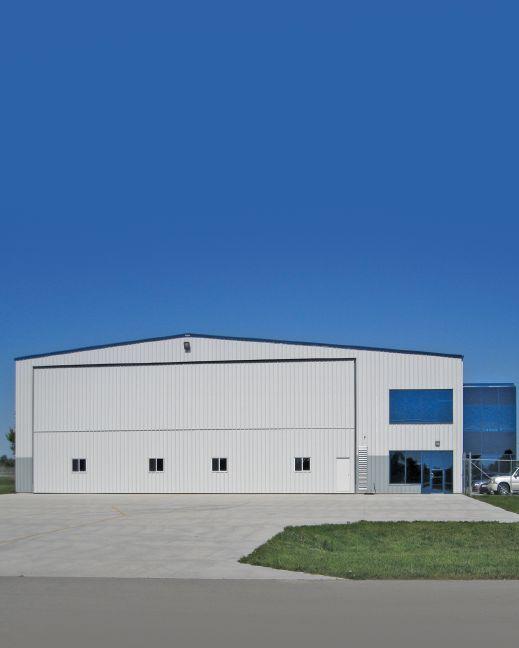


Edward Smith | guest columnist
Helicopters draw a lot of attention with their almost magical ability to hover, fly in any direction and operate without runways. They save many lives, often dramatically, with their extensive use in all-weather military missions, ambulance duties and searchand-rescue roles. When things go wrong, dramatic images and news stories about helicopter accidents grab public attention.
However, modern rotorcraft are safe. Each year, the U.S. commercial helicopter industry flies about three million flight hours. There were 0.77 fatal accidents per 100,000 flight hours on average from 2018 to 2022. In comparison, the general aviation sector averaged 0.88 fatal accidents per 100,000 flight hours over the same period.
As an aeronautical engineer who specializes in rotorcraft and the director of a national vertical lift centre of excellence, I have observed academic, government and industry efforts to improve helicopter safety. A lot of technology and training have gone into making helicopters safe.
Rotary-wing aircraft were first developed over a century ago. The first to go into mass production was the autogiro, developed in 1923 by Juan de la Cierva in Spain. The pinwheel-like nature of the main lifting rotor avoided the dangers of stalling, which wrecked so many fixed-wing aircraft during that era. Within 15 years, the first true helicopters with powered rotors – capable of hovering, low-speed flight and safe descent in the event of engine failure – were in the air in both Europe and the U.S. Large-scale military and commercial production began just a few years later during World War II.
Today’s helicopter operations are anchored on three main principles: comprehensive vehicle design, testing and manufacturing; well-trained flight crews; and thorough maintenance practices. Advanced technology plays a vital role in each of these pillars of helicopter safety.
Helicopter safety begins with the fundamental capability of large-diameter rotors that can auto-rotate in the event of engine failure. With the engine off, the rotors spin

Today’s helicopters typically have adaptive controls that help pilots feel different flight conditions.
freely, slowing the helicopter’s decent and allowing parachute-like controlled landing. Reliable powertrains – engines, gear boxes and driveshafts – long-lived blades and lowvibration airframes have also paved the way for safer flights.
Advanced autopilot and computer-controlled or assisted flight controls, terrainavoidance radar and rotor blade deicing systems that enable all-weather flight have become common on modern helicopters. Decades of basic and applied research conducted in university, government and industry laboratories has yielded many advanced technologies. Today’s helicopters typically have radar- and lidar-based collision avoidance systems, comprehensive digital terrain mapping databases and adaptive controls that help the pilot feel differences depending on flight conditions and aircraft characteristics such as payload.
Rotorcraft do require specialized pilot training to master. Pilots often train on fixed-wing aircraft before transitioning to rotary-wing vehicles. Pilots spend many additional hours or even years of flight instruction to earn a helicopter license.
Rotorcraft feature more moving parts than fixed-wing aircraft, which makes careful design of bearings, gearboxes, shock absorbers, lubrication systems and other
mechanical components critical. As with pilots, helicopter mechanics need additional training hours and skills. For some complex military and rescue missions, mechanics fly along as integral members of the flight crew. These flight mechanics closely monitor critical systems using onboard temperature, vibration, noise and metal chip sensors, and can even troubleshoot and repair many mechanical, electrical and digital issues that arise. Advanced sensors and software make maintaining helicopters quicker and more thorough. Advanced design and manufacturing methods also account for rugged composite materials.
The vast majority of helicopter accidents involve a complex chain of events. Pilot or mechanic error, typically associated with unusual circumstances, is a primary cause and bad weather often contributes. Many essential flight operations such as search and rescue, firefighting and military transport necessarily occur in sandy, snowy, smoky or stormy environments. These edge of the envelope conditions raise the risk factor, despite the best technology and training doctrines. Even the intense and realistic training exercises for these missions can be inherently more dangerous than standard flight.
New technologies continue to improve flight safety under these difficult conditions. These include more effective, reliable and lower power rotor blade deicing or anti-icing systems; improved weather forecasting models; and even onboard icecloud detection systems. Researchers are developing AI-enabled systems that help pilots decide when and if it’s safe to fly. | W
Edward C. Smith is a Distinguished Professor of Aerospace Engineering, Director: Vertical Lift Research Center of Excellence, Penn State. This article was originally published by The Conversation.

